|
|
Post by codystarbuck on Jul 31, 2021 11:11:45 GMT -5
Mike Grell writes and draws big heroes. He's handled the big names, at DC: Superman, Batman and Green Lantern & Green Arrow (okay, the B-team). He juggled the mass of characters of the Legion of Super Heroes, complete with funky 70s costumes. He put Cosmic Boy in a corset (sort of). He gave the world Travis Morgan, the Warlord, an Air Force SR-71 pilot, running around in a loin cloth and a helmet with big honking wings! Warlord was Grell's own creation, adapted from a newspaper comic strip pitch, called The Savage Empire. The original idea was a bit different, missing the pilot hero (I believe he was an archeologist or something along those lines). He was rejected by the syndicates, because adventure wasn't selling and the comics were shrinking. 3-4 panel gag strips were the big deal; simple drawings, basic joke structure. However, Grell kept his samples and they, along with other work, helped get him a job at DC and an Aquaman story. Later, Atlas/Seaboard started up, with Martin Goodman trying comics again, after selling out. Son Chip was passed over to head Marvel, so now he was going to prove Cadence Industries wrong. Daddy wanted him to succeed and shelled out some money to get top talent (better than he paid them, at Marvel) and made promises of partial ownership. One of the people who signed a deal was Mike Grell, to do Savage Empire. Grell was still working at DC and wanted it kept quiet. Jeff Rovin wanted to crow about it and let the cat out of the bag, to Carmine Infantino. Carmine confronted Grell and asked why he didn't pitch it to them. Atlas crashed and burned, with broken promises and poor distribution. Warlord became DC's top seller, in the mid-late 1970s. Out of that, Grell worked up a reverse concept of barbarian hero, thrust into an advanced future, with the fate of the Earth at stake. He signed with new upstart, Pacific Comics, becoming their first pro talent, though Jack Kirby got his book out sooner. Starslayer was a modest hit, but better known for launching The Rocketeer and Groo the Wanderer. Pacific crashed and burned in heavy debt and broken promises and books scrambled to find homes. Eclipse ended up with most. Starslayer was homeless. Then, Mike Grell got a call. Mike Gold, who Grell knew from his time as an editor, at DC, contacted Grell about a new company, starting up in Gold's hometown of Chicago. Gold was hired to manage the line, while Joe Staton had been hired as the art director. Did Grell want to come and play in their sandbox? The new company, First Comics, was offering ownership, just like Pacific (well, sort of). DC owned Warlord, lock, stock and Automag, because of their terms of contract. Grell saw the opportunity to do an idea he had been simmering for a while: a mature title of international intrigue, hardboiled detectives, big game hunting, and men's adventure pulp fiction, all rolled into one man: Iron Mike. Grell signed on; but, what started out as a private eye concept, Iron Mike (Grell's nickname, at DC) morphed, as he added some James Bond, some Peter Capstick, some old fashioned pulp fiction, and a healthy dose of his own sense of humor. Iron Mike changed his name; to Jon Sable, Freelance. 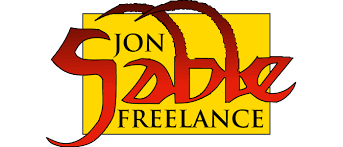 Jon Sable is a mercenary; he takes on dangerous jobs for money: bodyguard, bounty hunter, security, soldier-for-hire. He works strictly freelance (Duh! It's in the title!), answering only to the client. Sable also writes children's books, about leprechauns living in central Park, under the name BB Flemm. What does BB stand for? Anything from Bilbo Baggins to Buford Bertrand. He is also haunted by three lives, snuffed out in an instant, by poachers. Sable went out and hunted down the men who killed his wife and two small children, but they still don't rest. Not in his mind. It was a rich world and a complex character, named after an antelope, though sharing that name with a weasel. (That's right, an antelope named Jon!) It was a hit from the first issue and helped establish First Comics as a company out to change the landscape, along with Howard Chaykin's American Flagg, Joe Staton's old fan favorite, E-Man, an adaptation of Mike Gold's old connections, Warp, and Grell's other hero, Torin MacQuillon, aka Starslayer, which helped launch an adventurer, in an interdimensional nexus, written by a theater actor, named John Ostrander. Over the course of the 1980s, First Comics kicked gluteus and took sobriquets and Jon Sable was right at the heart of the mix. It would launch a tv series (briefly) and be optioned for (unproduced) movies and even get a book deal (but only publishing one book out of a contracted 3). But, all of that is later. For now, we will concern ourselves with the adventures of sports writer/athlete-turned-big game hunter/safari guide-turned-Game Control Officer-turned-manhunter-turned-soldier-for hire-turned-failed novelist-turned-mercenary-turned children's author, Jon Sable, Freelance So, pull out your best black turtleneck and slacks, polish up your favorite Chinese Bolo Mauser, apply your facepaint, and hop into your Studebaker, as we explore the action-packed and surprisingly funny world of Jon Sable, Freelance. Join us as we answer the question, "What's the deal with the lightning bolts?" and watch readers accept mass murder of humans but get bent out of shape after killing one antelope. |
|
|
|
Post by Deleted on Jul 31, 2021 11:36:43 GMT -5
Yet again love your choice of topics! And a wonderful introduction/preceding retrospective on Grell to tee things up.
First Comics was really an amazing phenomenon back in the 80's when you think of all the talent it attracted (or inherited from the ashes of Capital Comics). Jon Sable was really interesting territory for Grell, looking forward to following this thread.
Oh, and I know you qualified the comment on Cosmic Boy's "corset", I'm sticking with it was a colorist error, I can't get my head around that being intentional, crazy as the 70's were. Between that and Night Girl's outfit, they were easily the "least dressed" couple of that era!
|
|
|
|
Post by codystarbuck on Jul 31, 2021 11:41:42 GMT -5
ps. The title of this thread comes from a remark that artist Myke Blackmon makes, to Sable, after meeting him (as Sable), which gets repeated a few times in the series. I have never seen Grell confirm it in print; but, I'm pretty sure it is an in-joke, referring to what fans often remarked, upon meeting the man who created and Drew Warlord, Starslayer and Jon Sable. I met the man in the early 2000s and I am 5ft 6 in (Thanks, Mom!). Grell was no taller. Based on his work, you expected a guy that looked like John Wayne.
Now, Mike Gold is one great big SOB and it's no wonder Elliot Maggin chose to sucker punch him, rather than come at him directly, as he probably wouldn't have gotten in the one good shot.
That's a story for another time.
|
|
|
|
Post by codystarbuck on Jul 31, 2021 11:47:08 GMT -5
Yet again love your choice of topics! And a wonderful introduction/preceding retrospective on Grell to tee things up. First Comics was really an amazing phenomenon back in the 80's when you think of all the talent it attracted (or inherited from the ashes of Capital Comics). Jon Sable was really interesting territory for Grell, looking forward to following this thread. Oh, and I know you qualified the comment on Cosmic Boy's "corset", I'm sticking with it was a colorist error, I can't get my head around that being intentional, crazy as the 70's were. Between that and Night Girl's outfit, they were easily the "least dressed" couple of that era! Grell said it was deliberate. Cockrum had slightly updated the look of Cos' traditional uniform, which was always pink and black. Grell gust removed the pink parts and had bare flesh, witht he human body providing the pink! I first read the Legion, under Grell, so I didn't know any better. I like the look of the black, with the little silver accenting, on the gloves and boots and abdomen. I would then see reprints of the older stories and the original costume, in the DC Digests. It didn't click, until much later, that Grell had substituted flesh for cloth. It didn't dawn on me until even later why Cosmic Boy's outfit always seemed a little odd: I realized it was a corset! So, Saturn Girl got thigh boots, with platform heels and Phantom Girl got bell bottoms (both from Cockrum); but Cosmic Boy got fetish wear! |
|
|
|
Post by Deleted on Jul 31, 2021 11:58:26 GMT -5
Yet again love your choice of topics! And a wonderful introduction/preceding retrospective on Grell to tee things up. First Comics was really an amazing phenomenon back in the 80's when you think of all the talent it attracted (or inherited from the ashes of Capital Comics). Jon Sable was really interesting territory for Grell, looking forward to following this thread. Oh, and I know you qualified the comment on Cosmic Boy's "corset", I'm sticking with it was a colorist error, I can't get my head around that being intentional, crazy as the 70's were. Between that and Night Girl's outfit, they were easily the "least dressed" couple of that era! Grell said it was deliberate. Cockrum had slightly updated the look of Cos' traditional uniform, which was always pink and black. Grell gust removed the pink parts and had bare flesh, witht he human body providing the pink! I first read the Legion, under Grell, so I didn't know any better. I like the look of the black, with the little silver accenting, on the gloves and boots and abdomen. I would then see reprints of the older stories and the original costume, in the DC Digests. It didn't click, until much later, that Grell had substituted flesh for cloth. It didn't dawn on me until even later why Cosmic Boy's outfit always seemed a little odd: I realized it was a corset! So, Saturn Girl got thigh boots, with platform heels and Phantom Girl got bell bottoms (both from Cockrum); but Cosmic Boy got fetish wear! I didn't know he confirmed it, hah! I think it was a good thing though because it gave some "equality"...anytime someone might critique Saturn Girl's outfit as being risque, you could always reference Coz. Guys and gals were all fair game! |
|
|
|
Post by codystarbuck on Jul 31, 2021 16:53:23 GMT -5
Jon Sable #1 First reaction (pun intended): That's a pretty cool looking superhero, with that sweet Mauser! I was 16 and a gun nut; go figure. I was a little late to the game, buying the 2nd and first issues at the same time, soon followed by the third and fourth. I missed the fifth, but got the 6th. Then, I missed out on the rest, as I got busy, getting ready to go off to college and NROTC. Indicia Gag: "Read throughout the known universe." Creative Team: Mike Grell-story & art, Peter Iro-letters, Janice Cohen-colors, Mike Gold-editor First Comics was based in the Chicago area (in Evanston, initially) and used a lot of local talent. Mike Grell was living in Wisconsin, at the time. So, some of the names you may see with First Comics will be rookies from the Chicago environs, breaking in. others were veterans, like colorist Janice Cohen, who worked at Marvel. That was another thing to like about First Comics: they were local (for me, living in downstate Central Illinois). Marvel and DC were off in far away NYC. The closest we got to our own comic company, in the Midwest (not counting other 80s indies and self-publishers) was Western/Gold Key/Whitman, who were based out of Racine, WI, though I believe the comic production was done on the West Coast. This is how you get people involved in the Organic Theater Company involved in comics (Gold had worked with them and John Ostrander had written and acted in productions with them). It's also how you get people like Chicago actor/writer/teacher Del Close, of Second City fame, involved and even do a role on the Sable tv series (Close co-wrote Wasteland, with John Ostrander). Synopsis: Our story opens with a tv interview, with children's author BB Flemm, as he talks about his book series, featuring leprechauns, living in Central Park. 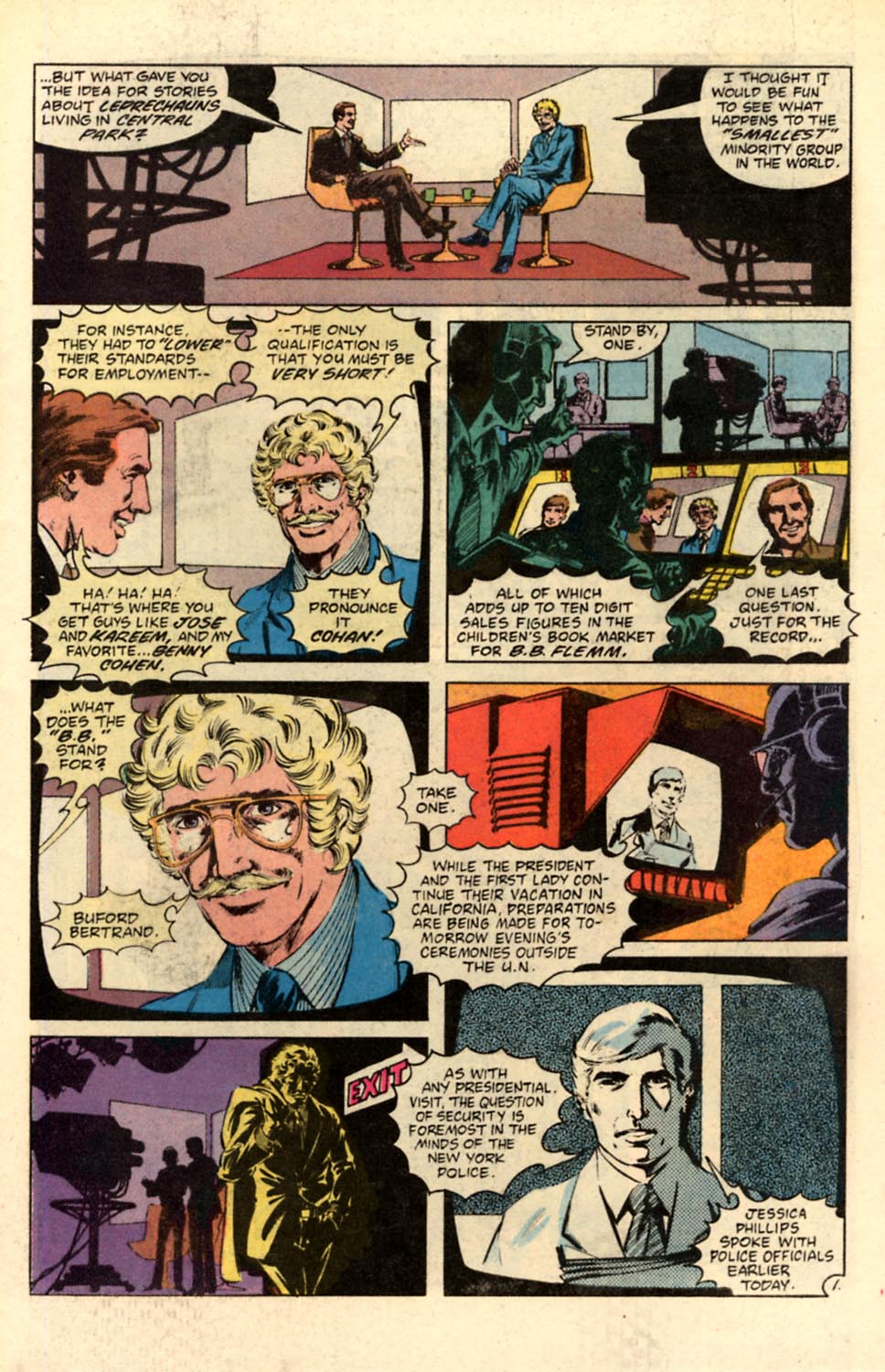 After the interview, they segue into a piece on president Reagan's upcoming visit to the UN, and security. Police captain Josh Winters, head of the security detail, is interviewed and gets hostile when private security is mentioned and goes on the offensive about media coverage of the recent Dahl Case. This is juxtaposed by BB Flemm walking through the streets of New York, eventually coming to a ritzy brownstone. We cut to the inside of the brownstone, as Flemm takes off his trenchcoat and curly blond wig and fake mustache. Wait, WHAT? Patience, grasshopper! The reporter elaborates on the Dahl Case, that Winters referenced. Child slayer Richard Dahl was captured by bounty hunter Jon Sable, after he eluded the police. Sable is shown with his captive, wearing a bizarre "battlemask" and quipping that it "Scares the hell out of the bad guys!" Flemm lights a cigarette and we see his naked face for the first time: he is Jon Sable! Sable goes downstairs (presumably to a basement) and activates a computer, puts on hearing protection and pulls out a Mauser pistol, then waits for a signal. Soon, boards pop out, with pictures of people; some armed, some not. Sable runs through the gauntlet course, shooting the threats and avoiding the innocent, until he unleashes a barrage into an image of BB Flemm. The computer says he has hit a good guy. He retorts, "Tell it to the New York Times Book Review!" The revelry is interrupted by an alarm, indicating an intrusion upstairs. Sable heads up to investigate and interrupts a trio, as the come off the elevator, from the garage... 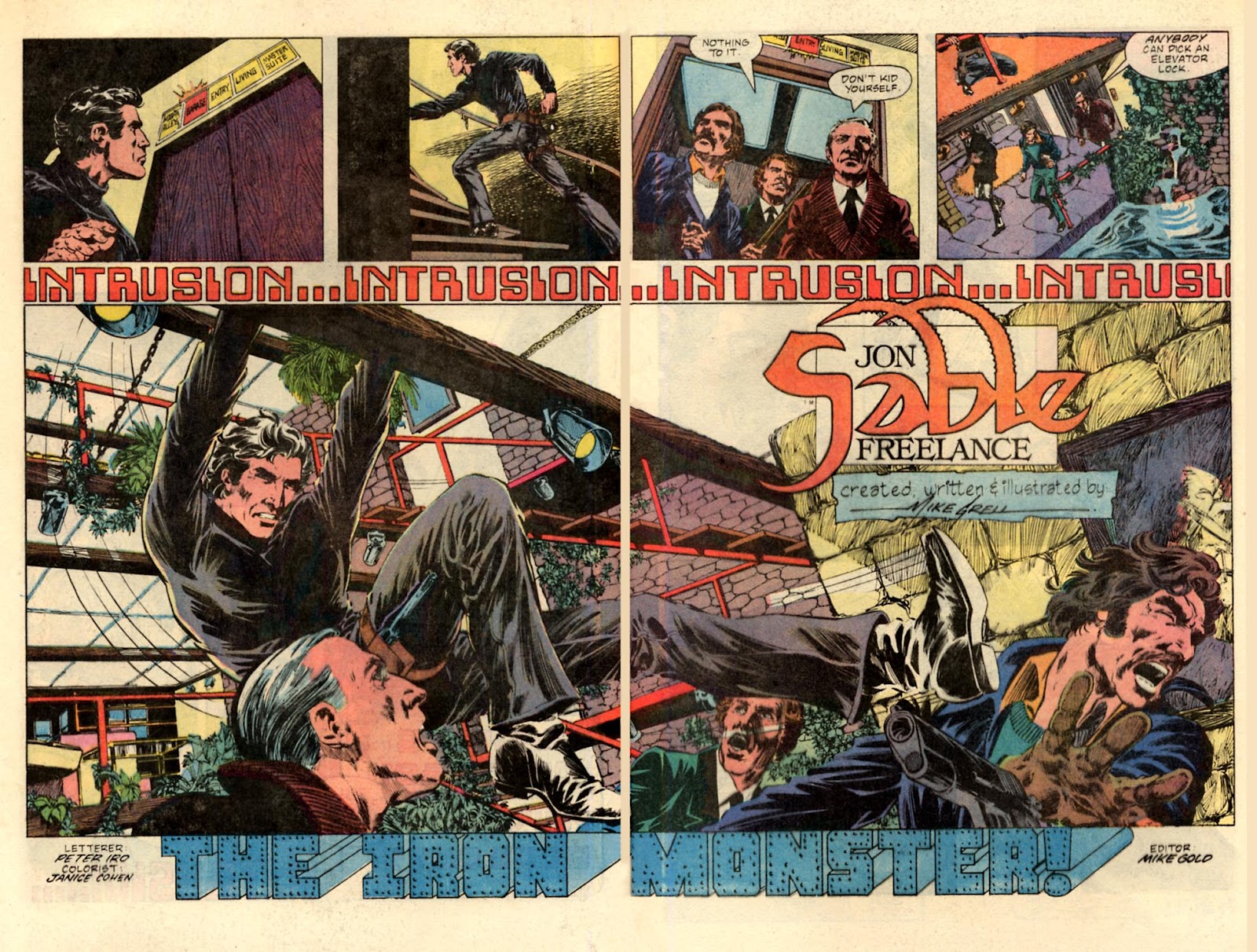 Sable's boot to the face takes down the first and he ducks under the second's attempt to club him and hip tosses him into a pool. The third comes at him with a knife and Sableblocks the thrust and pivots on his back leg, delivering a reverse elbow to the back of the attacker's head, smashing it into a brick wall. he pulls the wet attacker up by the hair and shoves the barrel of the Mauser in his face and asks for details. Sable then goes outside, to a waiting limo and gets in. The figure inside proceeds to brief him on a contract, to locate and stop a hitman. Sable says to let the Feds handle it, seeing as his employer is from the Federal government. The employer remarks about how people would react if they knew beloved children's author was mercenary Jon Sable, especially those who count him as an enemy. Sable knows he is hooked, but still wants to know why him. He is told the hired assassin is Milo Jackson and sable recognizes the name. He demands carte blanche to operate, that Josh Winters be leashed, and a favor to be named later. Sable then tells the jelly bean-eating employer to "Say hello to Bonzo," to which the retired actor remarks, "Bonzo is dead, Mr Sable." Sable winks at the man. Sable returns to his home and pulls out a book, with the Olympic rings and the title 1972 Olympics, Munich. he flips through and sees his own entry, as a pentathlete, on the page opposite target shooter and Silver Medalist Milo Jackson. He thinks back a few years, to 1979 and Rhodesia. Sable is in military uniform and a red beret, arm in a sling, and FN-FAL battle rifle propped at his table, as he drinks. Milo Jackson, in similar uniform, stops in, with another mercenary soldier and checks on how Sable's injured arm is. Sable will miss their patrol, which Jackson regrets. They share a toast, well known in the Congo... "VIVE LA MORTE, VIVE LA GUERRE; VIVE LA SACRE MERCENAIRE!" Jackson's patrol, out hunting for ZANLA and ZIPRA guerillas, is ambushed, with only Jackson surviving, since he is the one who deliberately led them into an ambush, for money. Sable recalls how he found out that Jackson had betrayed the men, after sticking a pistol in the face of a captured guerilla. The phone interrupts Sable's memories and it is Eden Kendall, his literary agent, remarking on the tv appearance. She invites him over for a drink, but he begs off. His loss...  Instead of making a booty call, Sable goes down to a bar, where mercenaries (mostly wannabes) hang out and asks for Mad Maxie. the bartender tells him he has a store in the Village (near the Green Dome, no doubt) and sells guns and supplies to survivalists, instead of revolutionaries. They are interrupted by some drunken armchair mercs who think Sable is all rep and no stones and Sable asks the bartender if he minds. He tells Sable to go ahead, just don't break anything valuable...  Sable disposes with the mouths and takes his 1953 Studebaker Commander to Mad Maxie's survival store and finds the front door open. He cautiously goes inside, weapon drawn, but get s hit over the head, from behind. Milo Jackson tells the fading Sable he needs to sharpen his instincts or it will be no fun.  Sable regains consciousness and finds a badly bleeding and dying Maxie, who spits out the words "Iron Monster," before dying. sable calls in Josh Winters and tells him what happened. Winters isn't buying it and rousts Sable, pulling his gun and threatening him with charges, under the Sullivan Law, when Sable retorts he has a license and flips him a card and says call the number. winters still has him pulled downtown and doesn't release him until 3:30 pm, the next day. Sable goes down the UN Plaza and sees workers repairing vandalism to a backdrop wall, with the UN motto, including holes that look like they were done with a hammer. he confers with one of the Feds whi broke into his place (nursing a swollen eye) and asks if he knows what an "Iron Monster" is? He then tells him it is a slang term for a "free rifle," and that Milo Jackson just stole one that fires a 5 inch grouping, at a thousand yards. The holes are bullet holes, from Jackson's target practice. At 5:00 pm, Sable gets a call and comes down to a building and is directed to a corner room, which Jackson had occupied. Sable can see the UN, but not the plaza and tries to figure out where Milo would have been positioned to test fire his weapon. He then notices a building under construction and rushes over to the site. The elevator is on the ground and Sable knows it is a trap. He scales up the I-beams and, by 6:00 pm, works his way behind Jackson's shooting nest and surprises him. he has his Mauser trained on him and asks, "Why?" 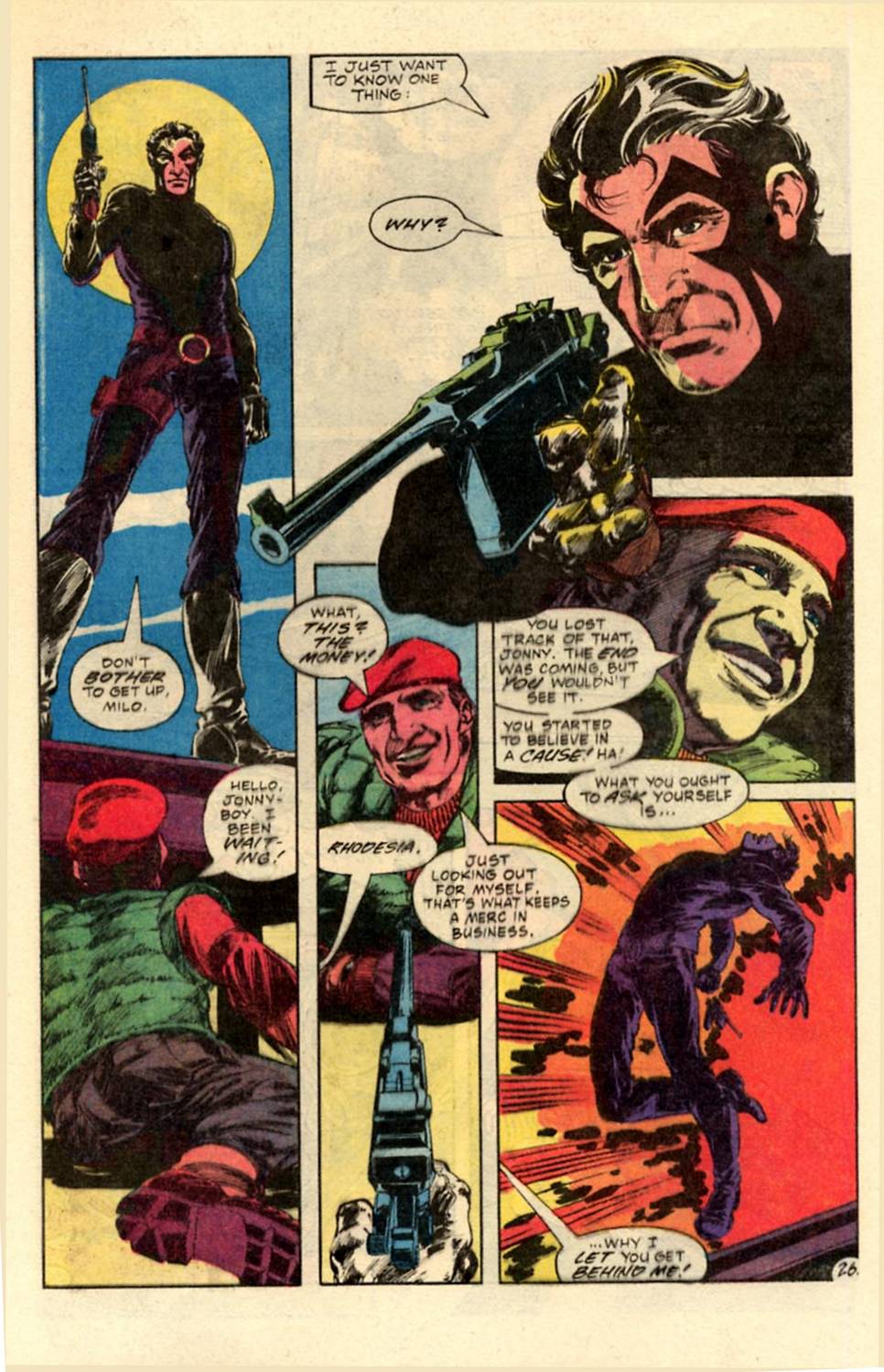 Milo says for the money, then triggers a booby trap he had prepared, knocking Sable off his feet and allowing Jackson to ready his shot, as President Ronald Reagan gives a speech and releases a dove. Sable is doubled over, from the blast, but also to mask his movement, as he withdraws twin hidden punch daggers from their sheaths, in his gunbelt buckle and he slices Jackson as he pulls the trigger on the free rifle, throwing off his aim, causing him to hit the dove and not the President of the United States. Later, Sable claims his favor and enters a darkened room, where he uses a computer to erase government files that indicate Jon sable and BB Flemm are one and the same. he returns the key to the room to Reagan and says he has been paid in full. Thoughts: Now that's a debut! Grell establishes this as something different from the start, as we see figures talking about characters from a children's series, then cutting to talk of the President's address to the UN. Sable is established on two pages as a hot-shot mercenary and a disguised children's author. Further scenes establish his prowess with a gun and in hand-to-hand combat, before we are thrown into the main plot. by this point, we know Sable is the real deal, which lets us buy into the idea of the President of the United States personally hiring a mercenary to find a hitman, who wants to kill him. It's the stuff of James Bond, yet it is believable, because Grell gave us the details to prepare us for that idea. He plays cagey with the figure in the limo, slowly setting up the reveal, as the face is hidden. When Sable asks if he is who he thinks the man is, Reagan holds up his American Express card (referencing the then-popular commercials), with his name conveniently hidden. He also pops jelly beans into his mouth and remarks that he should have won an Oscar. We don't need to see Reagan to know it's him. Later, at the UN, we see Reagan's face, as the dove explodes into blood and entrails, as the shot meant for him misses. Grell establishes part of the supporting cast, too. Josh Winters is an NYPD captain, who doesn't like vigilantes and private investigators, let alone mercenaries and bounty hunters. Winters will be a frequent antagonist, as Sable's cases cross into his territory. This is a common trop of Sable's other influence: hardboiled detective fiction. Usually, the gumshoe is at odds with the police, though he usually has a friend on the force, feeding him info. We'll meet Sable's insider, next issue. We also meet Eden Kendall, Sable's literary agent and casual lover. That element immediately establishes this as an adult series, as the implication of sex is pretty glaring. Grell is a smart writer, as he knows when to let the text tell the story and when to do it with the art and the scenes of eden and Jon talking on the phone mix both well... 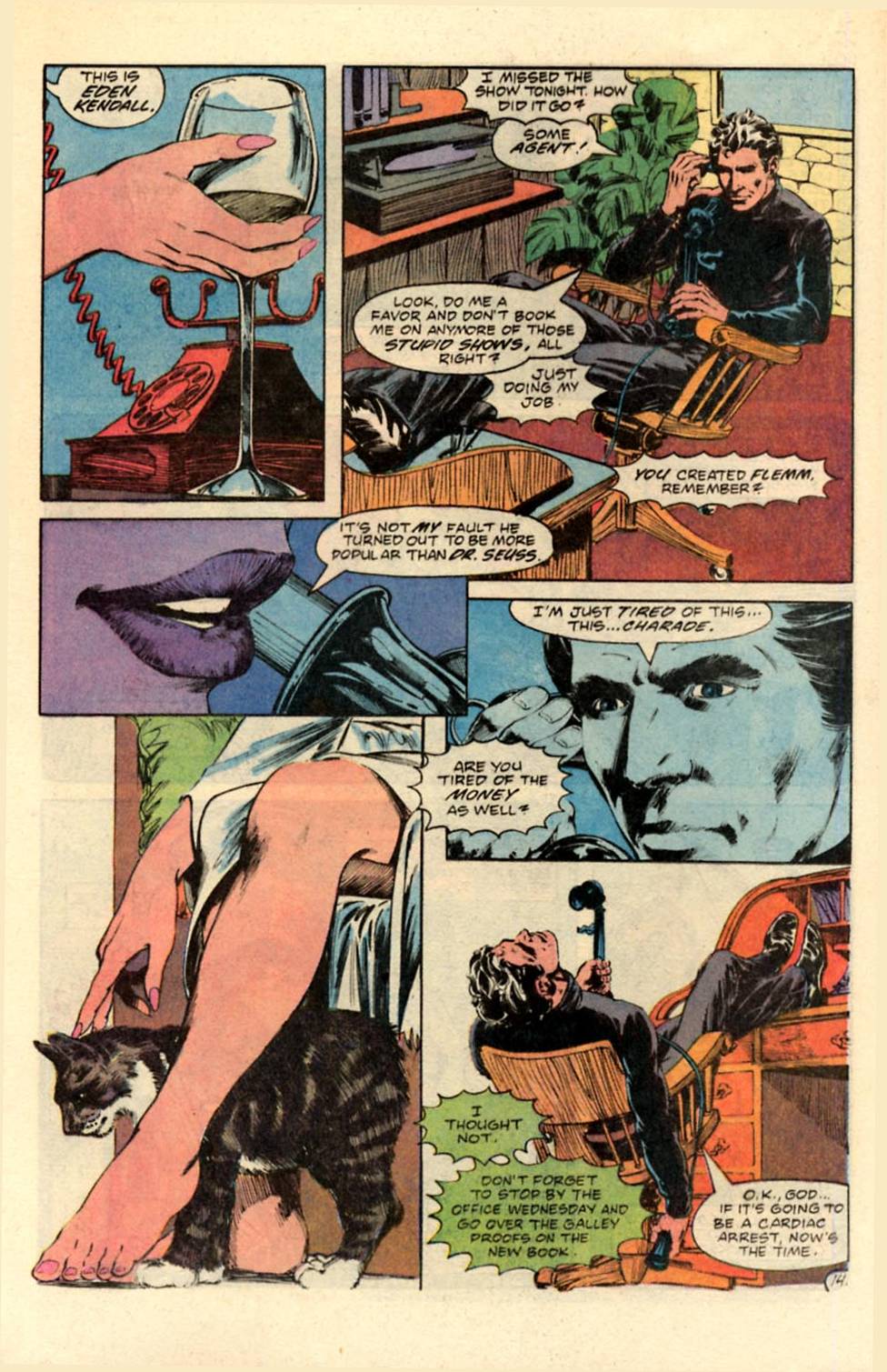 It establishes their business relationship and explains why Sable continues the masquerade, as it proves to be extremely profitable. Eventually, we will learn there is more to it than just money. Myke Blackmon, the illustrator of Sable's (Flemm's) books, gets name dropped and will turn up next issue. We then get the sexual relationship, as the very curvy Eden is seen in a slinky, figure-hugging nightgown, inviting Sable over for some liquor and sex, which Sable, regretfully, has to turn down. During the phone conversation, we see subtle things: Eden's hand reaching for a glass of wine, her scratching a pet cat, as it rubs up against her leg, not to mention the provocative panel of what sable turned down. In many ways, it is the opposite of Bond, as 007 would have already been in bed with the female lead. However, this is more of a Moneypenny situation, as we will come to see that we hear more of their past relationship than see it. Grell may draw inspiration from Ian Fleming, but he has a more mature and progressive outlook at adult relationships. Milo Jackson adds more backstory to sable, as they both competed in the doomed 1972 Munich Olympics and were soldiers-for-hire in the Rhodesian Civil War. Modern Zimbabwe began its life as a holding of the British South Africa Company and then a colony of the United Kingdom. Rhodesian soldiers (white and black) served alongside the British Army in WW2. In the 1960s, a winds of change were whispering for independence. in 1960, british Prime Minister Harold McMillan made a speech, to the South African parliament, that Britain would only allow independence to colonies where majority rule was in place, directly challenging the colonial governments of South Africa and Rhodesia, where only whites had the right to vote and apartheid was a fact of life and a chief source of cheap labor. Both countries balked at the pressure from outside and both separated from the UK, with Rhodesia declaring independence in 1965. Soon, the white government, under Ian Smith, would find itself mixed in a civil war with two groups, The Zimbabwe African National Union (ZANU), led by Robert Mugabe, and the even more radical Zimba African Peoples Union (ZAPU), led by Joshua Nkomo. Both were backed by the Soviet union and the People's Republic of China, as part of Cold War African politics. The two nations provided arms and advisors to the paramilitary wings of the two groups: The Zimbabwe African National Liberation Army (ZANLA) and Zimbabwe People's Revolutionary Army (ZIPRA), representing, respectively, ZANU and ZAPU. The white government was frozen out by the US and UK, directly (though there was indirect aid, against the Communist interest, via third parties) and turned to aid from South Africa and Portugal, who still controlled neighboring Mozambique (which had its own insurgency troubles). They also recruited foreign volunteers, and raised a force of about 1400, including many US soldiers, who had fought in Vietnam, as well as ex-members of the British Army and a smattering from other countries. However, these were not paid mercenary soldiers, like in the Congo, during the Katanga Secession. They volunteered for service within the existing Rhodesian Armed Forces, serving in military and police units. One such unit was the Selous Scouts, a group of counter-insurgency specialists, akin to US Army Special Forces, as well as the Rhodesian SAS (founded and trained with the British and Australian SAS). The Selous Scouts went into the bush, hunting down "terrorists," using such methods as prisoner snatches, assassination, and counter-terrorism. They were quite effective, but, of small numbers, in service to a repressive minority government. The Rhodesian government was fighting a lost cause, though ZANLA and ZIPRA clashed with each other as much as with the Rhodesian forces. Eventually, a compromise government and free elections were held and majority rule came to Rhodesia, with Robert Mugabe winning election (though fair and foul means) and the renaming of the country as Zimbabwe. Soon, the fears of the white citizens were realized, as decades of white rule and oppression were turned upon them and whites were intimidated into leaving or outright murdered. White ranchers were forced off of large holdings, which were confiscated and redistributed to cronies of Mugabe and others. Mugabe instituted himself as the sole ruler, from 1980 until 2017. So, Sable is given a backstory of being a foreign volunteer in the Rhodesian military. Grell later modifies this as being a CATU: Civilian African Tracking Unit; more of a militia force than a governmental unit. They worked with the British South Africa Police, who operated paramilitary units, The Police Anti-Terror Units (PATUs), who hunted for "terrorists." One former BSAP officer was daniel carney, whose manuscript, The wild geese, inspired the movie about mercenary soldiers, in Africa, starring Richard Burton, Richard Harris and Roger Moore. His manuscript was published with the release of the film and he also wrote a novel, The Whispering Death, based on the activities of the PATUs. In the Wild Geese novel, one of the mercenaries is Peter Coertze, a former member of the Rhodesian PATUs, looking to get back to Rhodesia (changed to South Africa, in the film, which was shot in South Africa) The "Iron Monster" that Jackson steals and uses is a "free rifle." These are, essentially, stripped down rifles, used for target shooting competitions, to reduce the weight of the weapon. They generally feature the bare essentials, carefully balanced to aid in accuracy.... 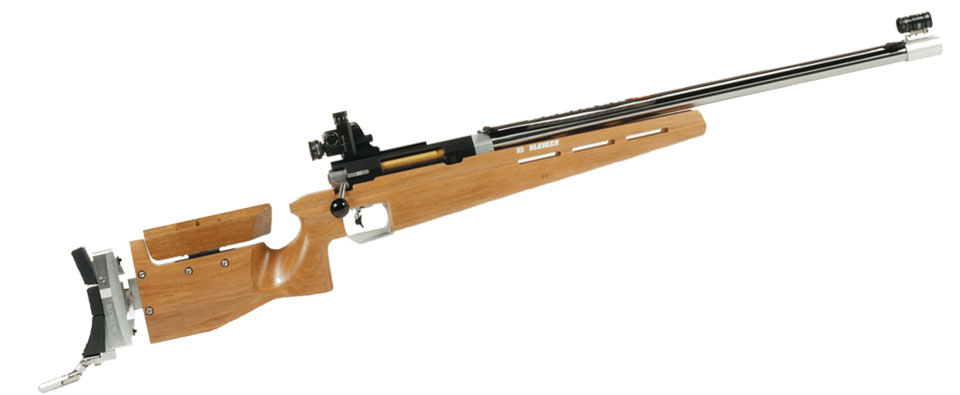 Jackson's is further stripped down to pretty much the breech, barrel, and trigger assembly, requiring a housing to hold it stable. This is similar to the weapon used by the Jackal, in Frederick Forsyth's novel, Day of the Jackal, and the subsequent film adaptation, with Edward Fox and Michael Lonsdale. 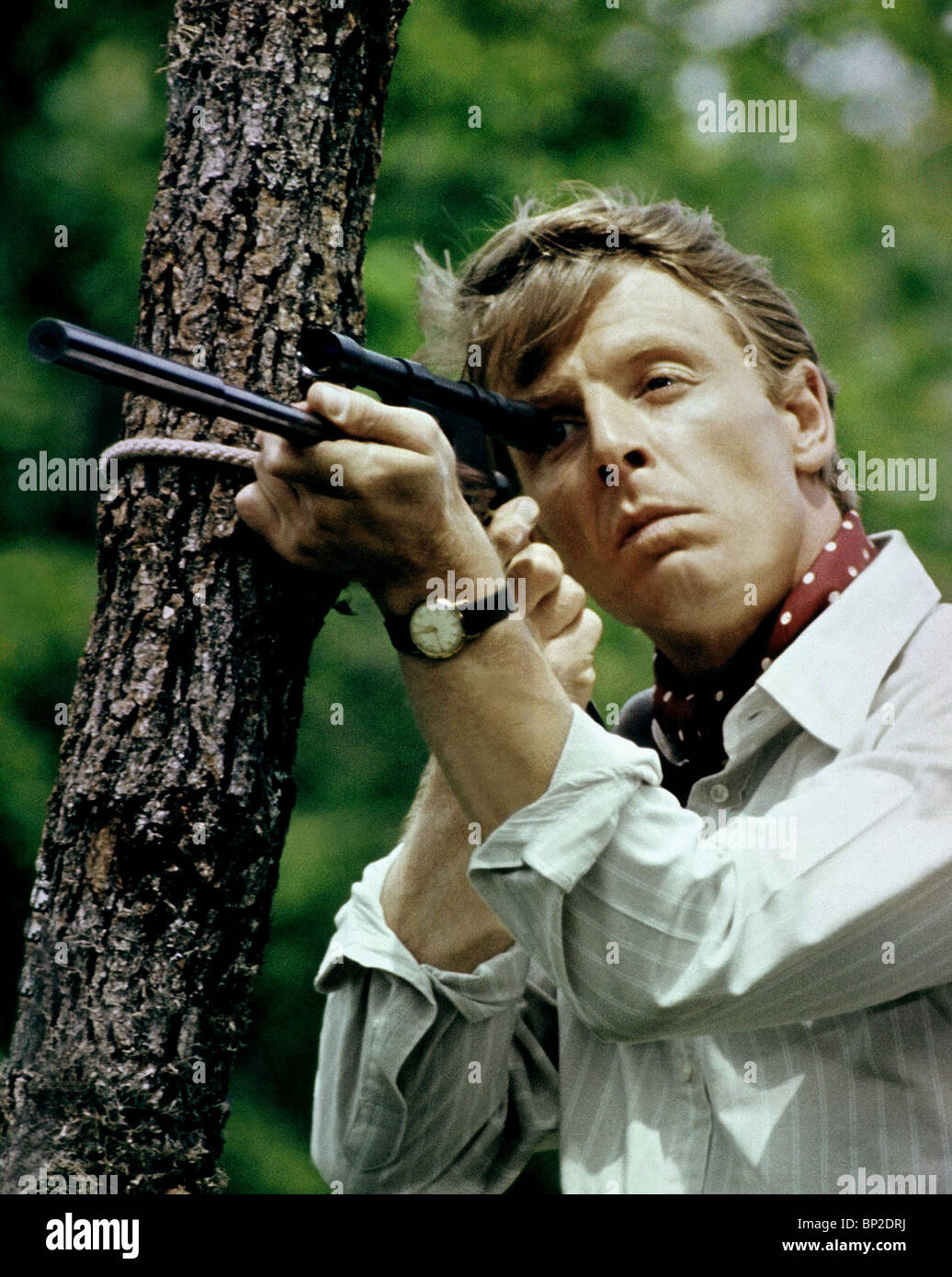 Sable is seen armed with what appears to be a C96 Mauser pistol... 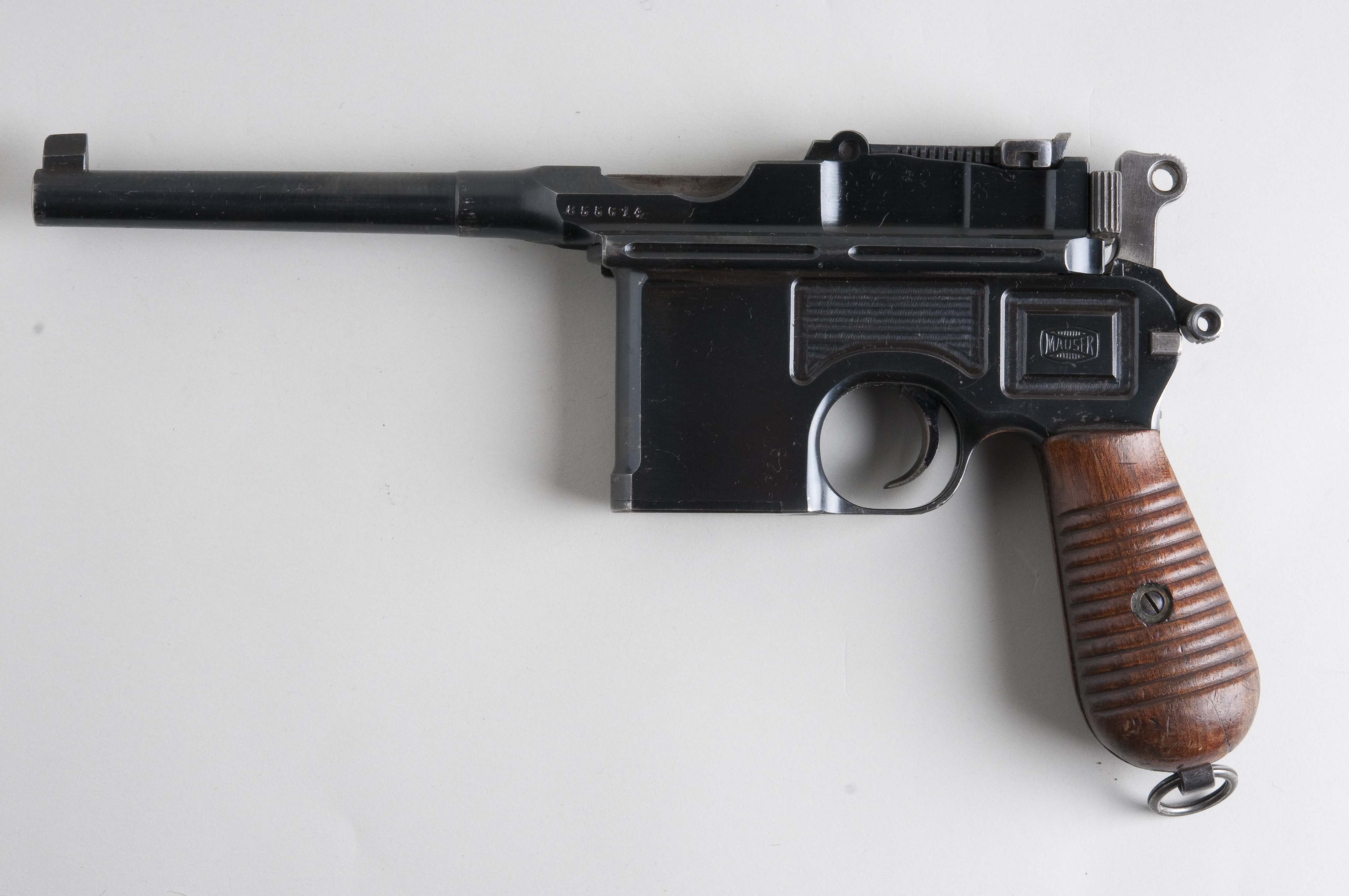 The pistol carried unique lines and was manufactured by the Mauser company, from 1896 to 1937. Winston Churchill famously carried one in South Africa, during the Boer War. It was usually chambered for either a 7.63x25 mm cartridge or a 9mm round (with a distinctive "9" carved into the wooden handle, to identify the chambering); but, some were manufactured in China, with a .45 ACP round, like the US M1911 Colt auto-pistol. It was used throughout China, during the warlord period, the Chinese Revolution and WW2 and Chinese Civil War. It would also provide the framework for Han Solo's blaster, in Star Wars. Subsequent issues will reveal that sable's Mauser is a hybrid mix of the Chinese Mauser and the Schnellfeuer M1932 version, which was capable of automatic fire (and had a detachable box magazine, instead of the standard Mauser internal magazine). Sable's is chambered for .45 ACP and capable of autofire. Early in the series, we see Sable loading it in the traditional manner: the breech is opened and ammo is loaded from the top, in a stripper clip, into the weapon. Later, we will see Sable insert a box magazine into the underside of the weapon. The Mauser was also notable for having a combination wooden holster/shoulder stock accessory, for use as a cavalry weapon. The stock was shaped as a holster and was hollowed out, to accommodate the pistol, with the butt end being hinged, to act as a cover for the holster. it would then be carried in a leather rig. The pistol would be drawn out of the stock/holster, then the holster would slot into a rail on the pistol grip and lock in place, allowing it to be held against the shoulder for better aiming. This can be seen in the Archie Goodwin/Walt Simonson Manhunter back-up series, in Detective Comics. Howard Chaykin also made the Mauser the favorite weapon of both The Scorpion and Dominic Fortune, while Joe Staton and Nick Cuti gave one to their PI, Mike Mauser. Sable's belt knives are inspired by similar actual models, marketed in the 1980s. The belt buckle would be the knife handle, which was attached to a punch dagger, designed to be thrust into an opponent. The blade of the knife fitted into a hollow sheath in the belt lining, and the belt holes were fitted over the notch on the buckle handle. It wasn't a weapon that you could quickly draw, but it was extremely camouflaged and subsequently outlawed in many states, along with boot knives, another popular 80s weapon that was the bane of existence for many a bouncer at bars and nightclubs. Sables gunbelt buckle is a metal circular piece and we see him grasp two segments and pull out the knives from their socket. The scale doesn't always match the size of the blades, but Grell mostly gets away with it. Although Grell was doing something more realistic, he still hedged his bets with Sable's fighting gear. Sable is clad in tight-fitting black, with riding boots, gloves, a holster rig and his "battlemask." In this issue, it appears to be a cloth mask; but, we will soon learn that it is actually camo make-up, inspired in tragedy, though the design is a fudge for the sake of making it look more like a mask. it doesn't hide Sable's features and his identity is public knowledge and it doesn't look particularly scary. in a couple of issues, we will learn its origin and true significance. In the early 80s, the men's adventure pulps, like The Executioner, the Destroyer, Nick Carter: Killmaster, The Penetrator and the death Merchant were still doing great business. They were a conservative literary reaction to the antiwar movement, during the Vietnam War, with added wish fulfillment, during a period of high crime rates, spawning entertainments like Death Wish and Dirty Harry, along with literary heroes Mack Bolan and remo Williams, who, in turn, inspired The Punisher and his ilk. Most of these characters were pretty one-dimensional, modern versions of classic pulp heroes, like The Shadow and The Spider, minus the more flamboyant trappings and a greater emphasis on guns and sex (and rather poorly written sex, in most cases). The earlier pulp heroes were usually more rich characters, though they had little growth across their series and used the same formulas for most adventures. This is both a plus and a minus, if you read many of them. for fans, you get the kinds of stories you like; but, you get the same story again and again, with little variance, except the villain's name and the locale. Grell sought to avoid this by mixing in some comic book conventions, like the dual identity and the children's books, making Sable an odd dichotomy. He further developed his character by having him act like a (relatively) mature adult, with mature relationships, rather than gratuitous sex. A relationship between Sable and a partner will develop over the series, but it will begin slowly and grow, bit by bit, with each issue, before the mutual love is consummated. Even then, ghosts will haunt Sable and interfere with his happiness. Mack Bolan had lovers; not a love interest. So, Sable is now established as an adventurer, with some odd trappings and interesting associates. Next issue will build upon that and introduce more supporting characters. Then, we go into Sable's past, as we learn why he is haunted and why he does what he does, why the "battlemask" and why he and Eden only have a casual relationship, beyond their business one. We will see how Sable gets his "injured wing," in Rhodesia and how he left the country, at the request (read command) of Robert Mugabe. Then, we will barrel on into action and adventure, mixing PI-type stories with James Bond thrillers, introducing more colorful and complex characters along the way. Lot of words; but, there's a lot going on, in this series.
|
|
|
|
Post by codystarbuck on Jul 31, 2021 17:07:47 GMT -5
ps. Why the "Indicia Gag?" Well, one of the things that set First Comics apart was the Indicia Gag. the indicia is the bit at the bottom of the splash page or inside cover, on comic books, with the copyright notice, the address for the publisher, the officers of the company and legal notices that say not to mess with their characters or they will sick their weasels....lawyers...on you. Nobody ever reads those things; so, First started putting gag lines into them. They repeated some; but, they usually had a new one with each issue of a series, though the same gag might appear in two different comics, released in the same month. Think of it like the moose gags at the bottom of the opening credits of Monty Python and the Holy Grail.
|
|
|
|
Post by foxley on Jul 31, 2021 20:55:43 GMT -5
Great analysis of the first issue, codystarbuck. I loved this series (although I didn't discover it until after it had finished), so I'm looking forward to your reviews. |
|
|
|
Post by Dizzy D on Aug 4, 2021 8:09:02 GMT -5
Just noticed this thread, I think Jon Sable is the only First Comics series that I actually have a decent amount of issues from (#2-#17 and #23 for some reason), so I'll try to keep up with the read along.
|
|
|
|
Post by brutalis on Aug 4, 2021 8:22:59 GMT -5
I knew of Grell from DC's Warlord which I dearly loved for all of it's ERB inspired sword and sorcery. Upon seeing the news and advertisements of Iron Mike's newest series I added it immediately to my LCS pull list so I wouldn't miss out. So glad I did for straight from the start Sable hit a lot of my sweet spots.
Hard boiled mercenarytough guy with a soft creamy (writes kids books? Oh wow) center filled with emotional heartache and soulful turmoil. Sexy women. Gunplay. Africa back history. Military background. Unique yet catchy cast. Struggling to do right in a world full of bad trying to overcome his own past. Soooooo much to explore, and boy does Grell deliver as writer/artist over the run.
Knew this one was special and a keeper from the get go.
|
|
|
|
Post by codystarbuck on Aug 4, 2021 10:21:04 GMT -5
I stumbled into it. We had no comic shops, in my area, at the time, and I picked up my comics from a spinner rack, at a mall bookstore. I stopped in at another bookstore, as a different strip-mall, which had used to carry a comic spinner rack. I saw they had one again; but, it was different. It was filled with comics I had neve seen before, some with characters I knew, like reprints of Marvel's Micronauts, as well as the fabled MLJ/Archie heroes (the Red Circle re-launch, with Rich Buckler). Then, I looked things over and found Jon Sable, the first 2 or 3 issues; plus, First Comics 2 or 3 issues of Starslayer. I snapped up Sable, as it looked cool as hell and I always loved Grell's work (we share a love for the Brandywine artists). I came back later for the Starslayer issues and then started making regular trips to the store. They were getting at least some of their comics via the Direct Market (probably Capital, since they were within the state, in Chicago). When I checked out, I noticed a big magazine-sized comic, called Nexus. Only glanced at the cover, though.
That opened a whole new world for me. American Flagg turned up within a couple of weeks and I snapped it up (Howard Chaykin and sexy women in stocking and stilettos). I got interrupted, eventually, by prepping for college and go off there, though I eventually found a comic shop. It was a bit haphazard, with newer stuff, but I saw that Sable had progressed while I had been absent (I missed quite a bit). I eventually found another shop (well, it opened up near campus, which I discovered when I returned from Summer Cruise), which had good back issue depth and picked up what I had missed. I also picked up the American Flagg graphic albums (collecting the first 3 issues, then the next 3) at the campus Student Union bookstore (which had a terrific sci-fi section and a growing graphic novel segment, in those early days, where I first discovered Lone Wolf and Cub).
|
|
|
|
Post by codystarbuck on Aug 4, 2021 16:24:12 GMT -5
Jon Sable #2 Looking a little less "superhero," on this cover. Still, when you think about it, the riding boots seem an odd choice. Steel-toed combat boots make a bit more sense and he could blouse his pants inside. Still, Grell is obviously hedging his bets, a bit. Indicia Gag: Read throughout the Known Universe. Creative Team: Mike Grell-story & art, Peter Iro-letters, Janice Cohen-colors, Mike Gold-editor Peter Iro did a bit of lettering at Charlton, on E-Man, in Charlton Bullseye and a little at DC. I suspect that Joe Staton was the connection for putting him with Grell. A lot of the later Charlton types were conencted with the CPL Gang, who were out of Detroit and Ohio, in many cases. He might have been a Midwesterner, which would make sense, for First. Janice Cohen worked extensively, at Marvel, as a colorist. She is also the daughter of Sol Brodsky; so, there is that connection. No idea if she was living in the Midwest, at that point or just picking up work at First. This was the dawn of the age of Fedex; so, you didn't have to live where the company was to work for them. Synopsis: In a dark, murky New York Alley, a wino is sleeping it off, when a .45 ACP Colt Automatic roars. the next day, as Jon Sable buys groceries at a neighborhood bodega, we see the headline "Bowery Slayer Strikes Again! Fifth Victim Identified!." Sable exchanges pleasantries with the shop owners, an older Jewish couple, when two men come in, armed with knives, demanding all of their cash. Sable goes into action... 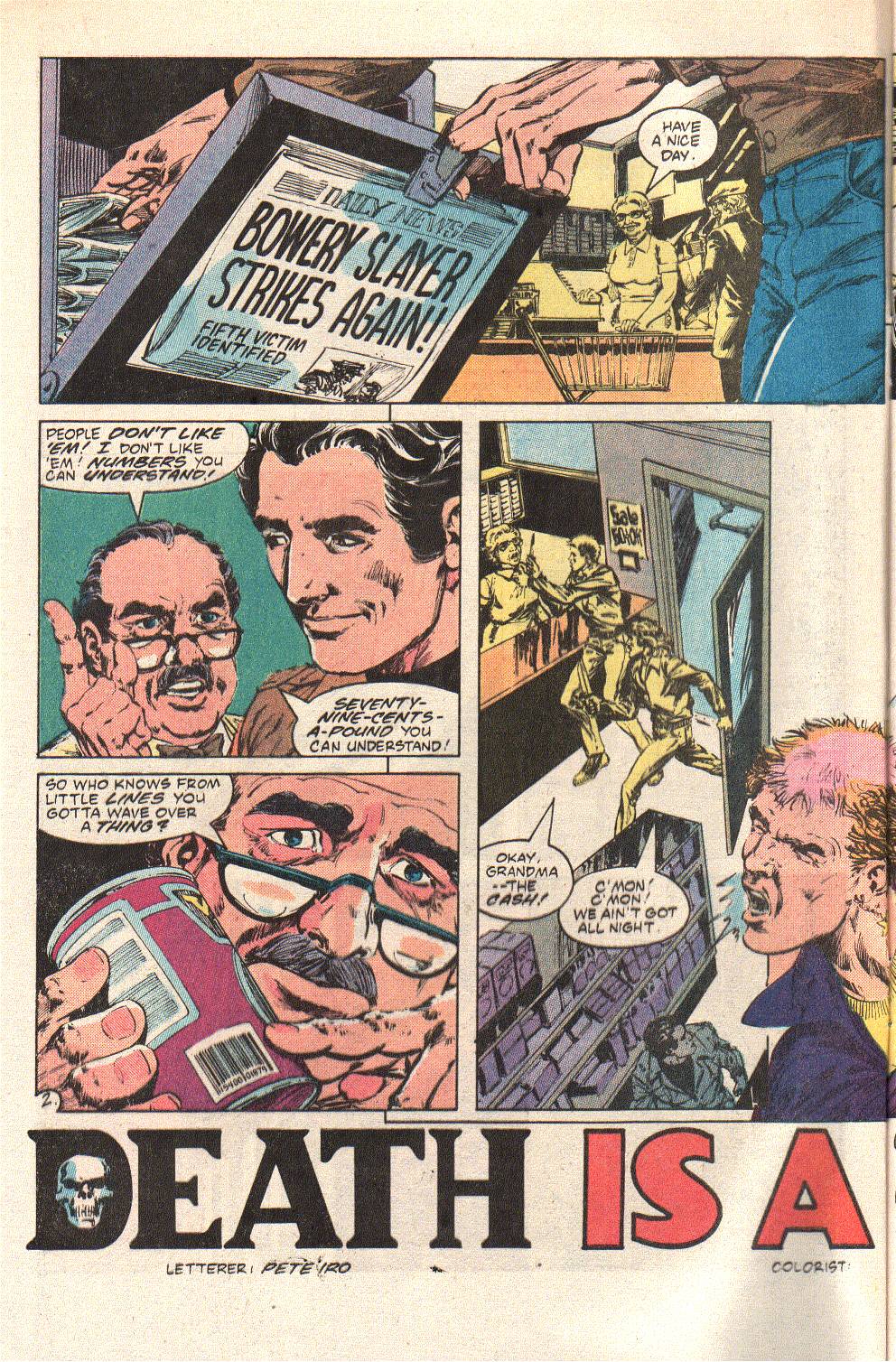 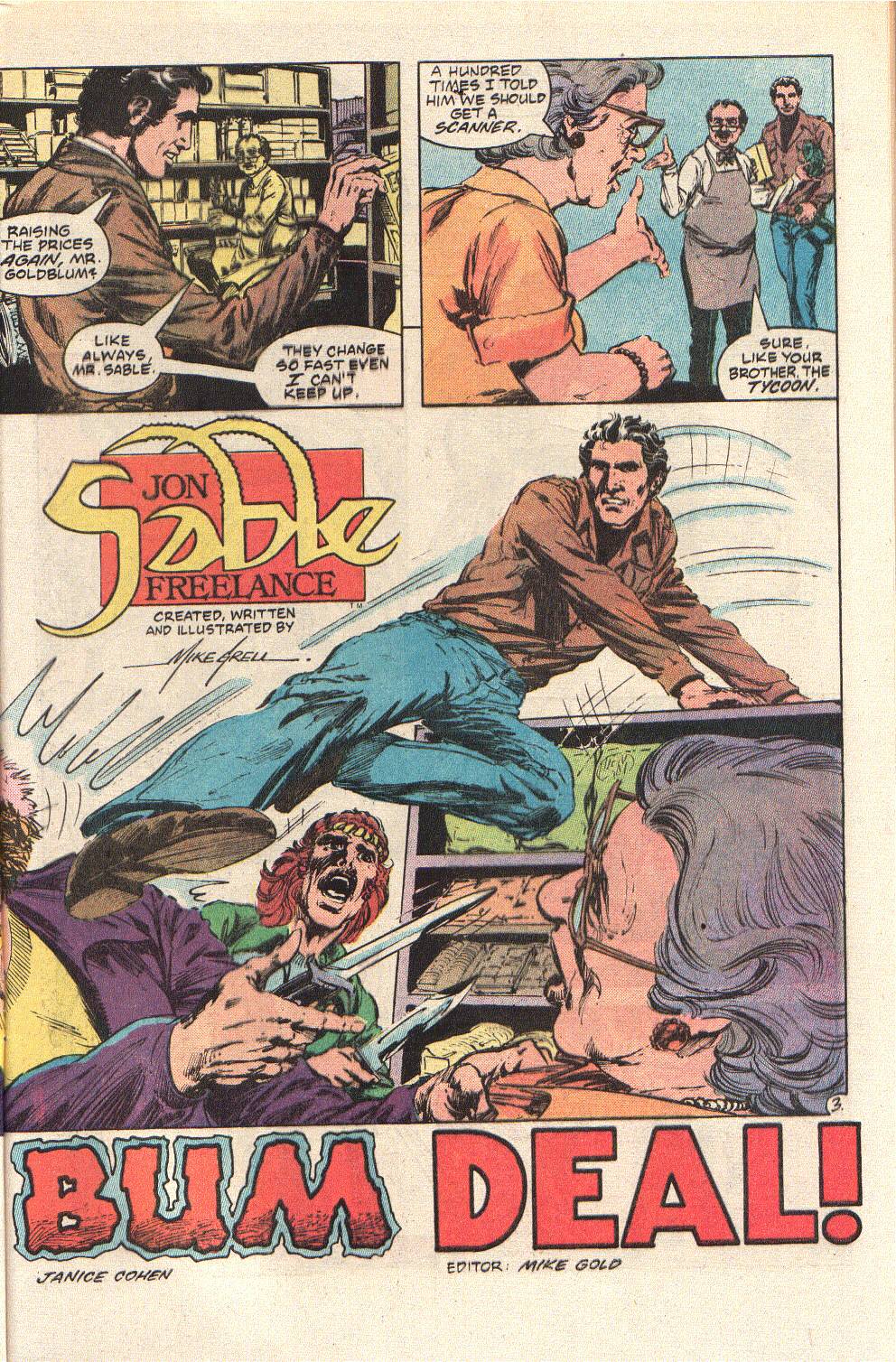 He takes the first one down with a kick and the hood's partner comes at him with a hunting knife. Sable slides a combat knife out of a wrist sheath and slices the hood acrossthe hand, severing his thumb and causing him to drop the knife. His partner had regained his wits and reaches for his knife, on the floor, when the shop owner bashes him in the back of the head, with a sponge mop handle. Later, Captain Josh Winters turns up and lays into Sable, quipping he thought Sable only worked for money. Sable affirms that and the shop owner pays Sable his fee....50 cents. Sable quips "The man drives a hard bargain," and walks away, as Winters rages about Sabe's continued interference in police matters. The next morning, Eden Kendall has a meeting with Myke Blackmon, artist on BB Flemm's books, when the author finally graces the office with his presence. He gets a shock, as he is introduced to Myke... 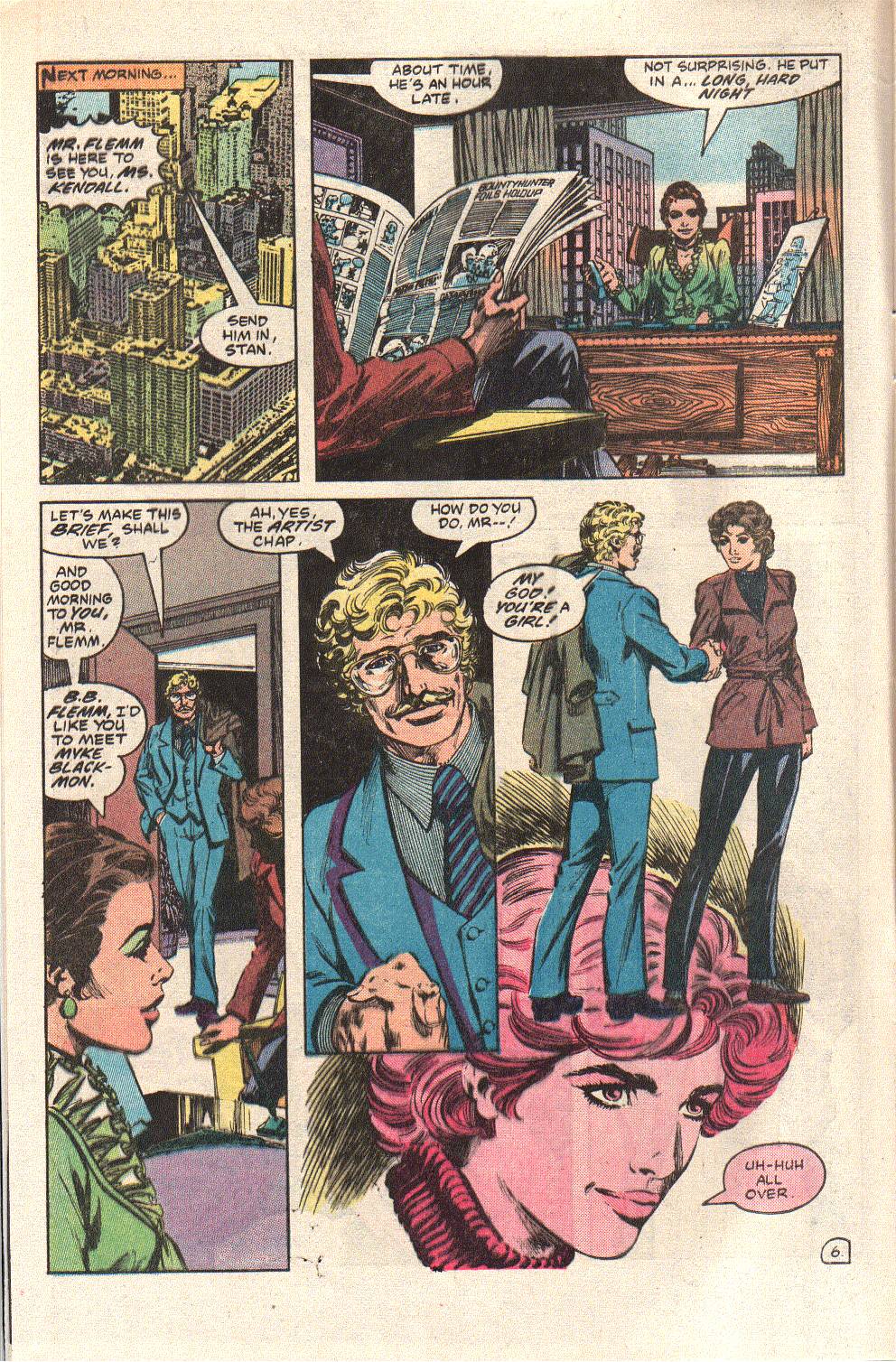 Flemm is flustered and tries to recover, but Myke gives as good as she gets, chiding the author for not giving her feedback earlier, since they have worked on his books for two years. Flemm decides to retreat and hands a list of corrections to Eden and leaves; but, Myke isn't having it. She follows, despite Eden's warning and hails a taxi and tells the driver to follow Flemm's Volkswagen Beetle. The cabby has waited for this moment, for 26 years and steps on it, following Flemm to a modern townhouse, in a neighborhood of brownstones. He waves his fare, as he has always wanted to do that. Myke rings the doorbell and a shirtless Jon Sable answers. She asks for Flemm and is told he isn't there. Myke retorts, "Uh-unh; his car's here and I saw him walk inside, he's here!" She pushes past Sable and then notices the swanky interior and makes a note to ask for a raise. Sable tells her to look around, if she doesn't believe him and she then asks if he is the bodyguard or boyfriend and the phone rings before he can make a comeback.... 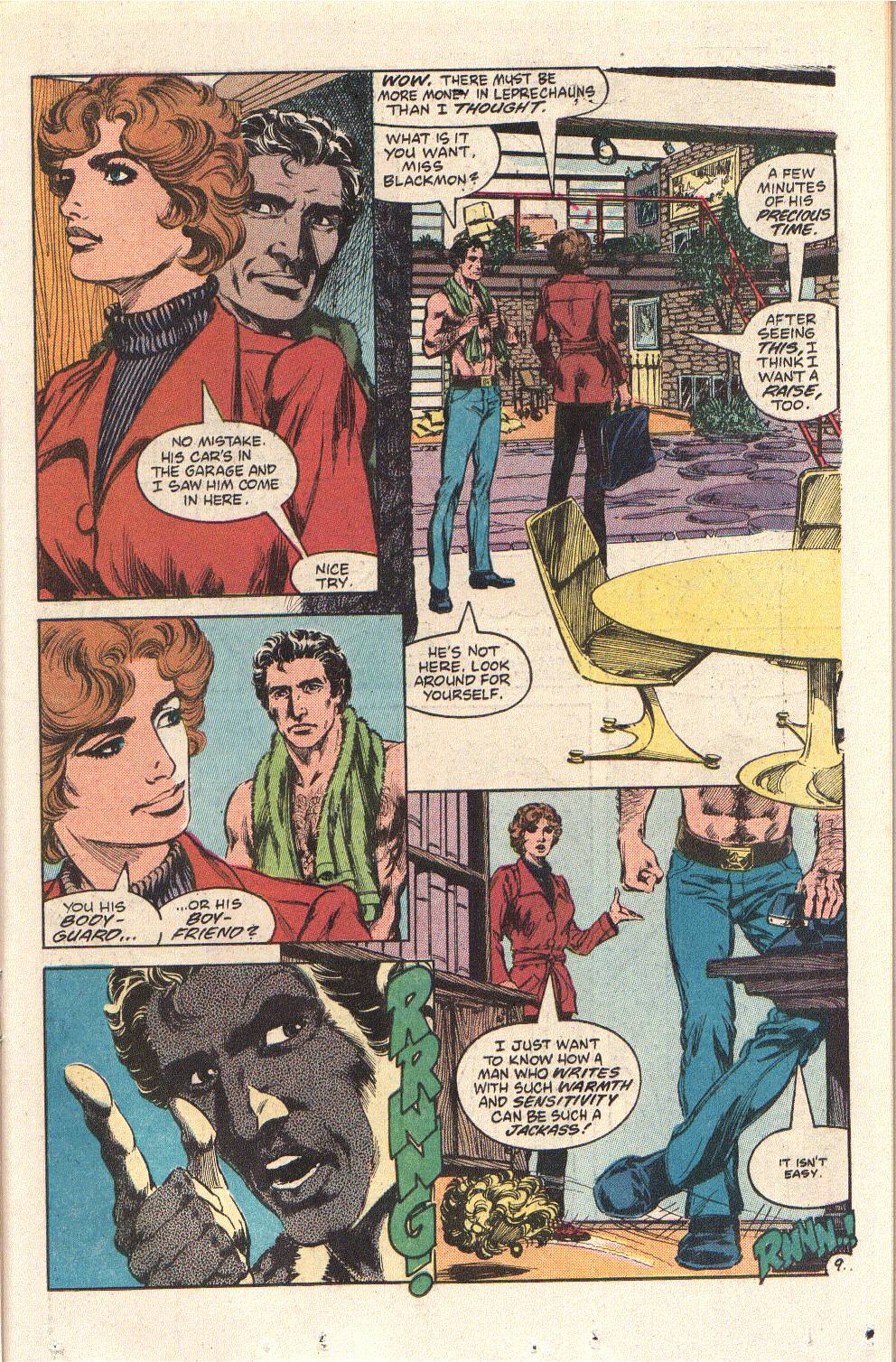 Sable gets a call from Laura Peters, the daughter of the Bowery Slayer's latest victim. She wants to hire him to find the killer and asks for a meeting. Sable makes an appointment and hangs up, and then finds Myke standing there, holding the Flemm wig, asking if he is Jeckyll or Hyde? Flemm replies "A little of both." Myke then hits him with his lack of communication about the books and her skills as an artist and I think Grell might be airing grievances of the freelance artist. She works up a good head of steam when able immediately says she is right and apologizes. Myke stutters to a halt and he offers to go over sketches now, before his appointment. Myke then addresses that Flemm is infamous bounty hunter Jon Sable; but is not what she expected, uttering the line that inspired my thread title... 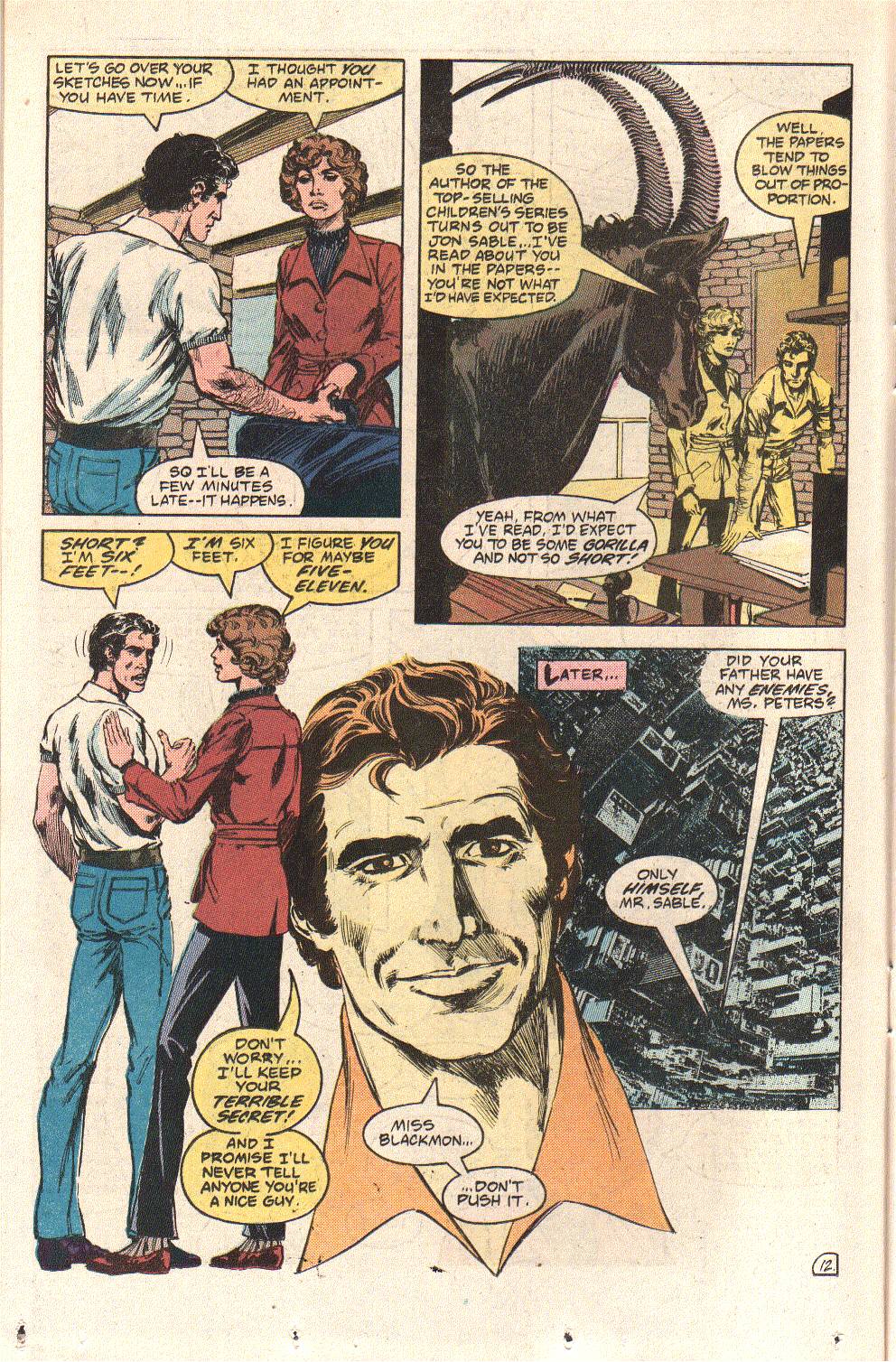 This becomes a recurring gag, as the 6 ft Myke pokes fun at Sable's shorter height. We pick up at a lounge, where Sable meets with Laura Peters. Her father had been an engineer, before the bottle ruined him. Sable remarks that the killings seem random and he is not sure what he can do that the police aren't. Laura rants, grieving for her father and demanding justice and revenge. Sable says he isn't a hired killer and Laura retorts with media accounts of killings. Sable responds that those were the choices of people who attacked him and he didn't kill them for pay. She asks, "Revenge? He nods, but says his own revenge. Laura demands her revenge and offers $25 grand up front and 25 when the man is brought in, dead or alive. Sable agrees to take the case and then says he needs to consult with a friend at the police precinct, to see what they have uncovered. he then hands Laura a phone number of someone else who can help: Alcoholics Anonymous, as Laura has downed drink after drink, during their meeting, just as her father destroyed his life with booze. Sable goes to the police station to talk with Harold, who turns out not to be a cop but a file clerk, and a Little Person... 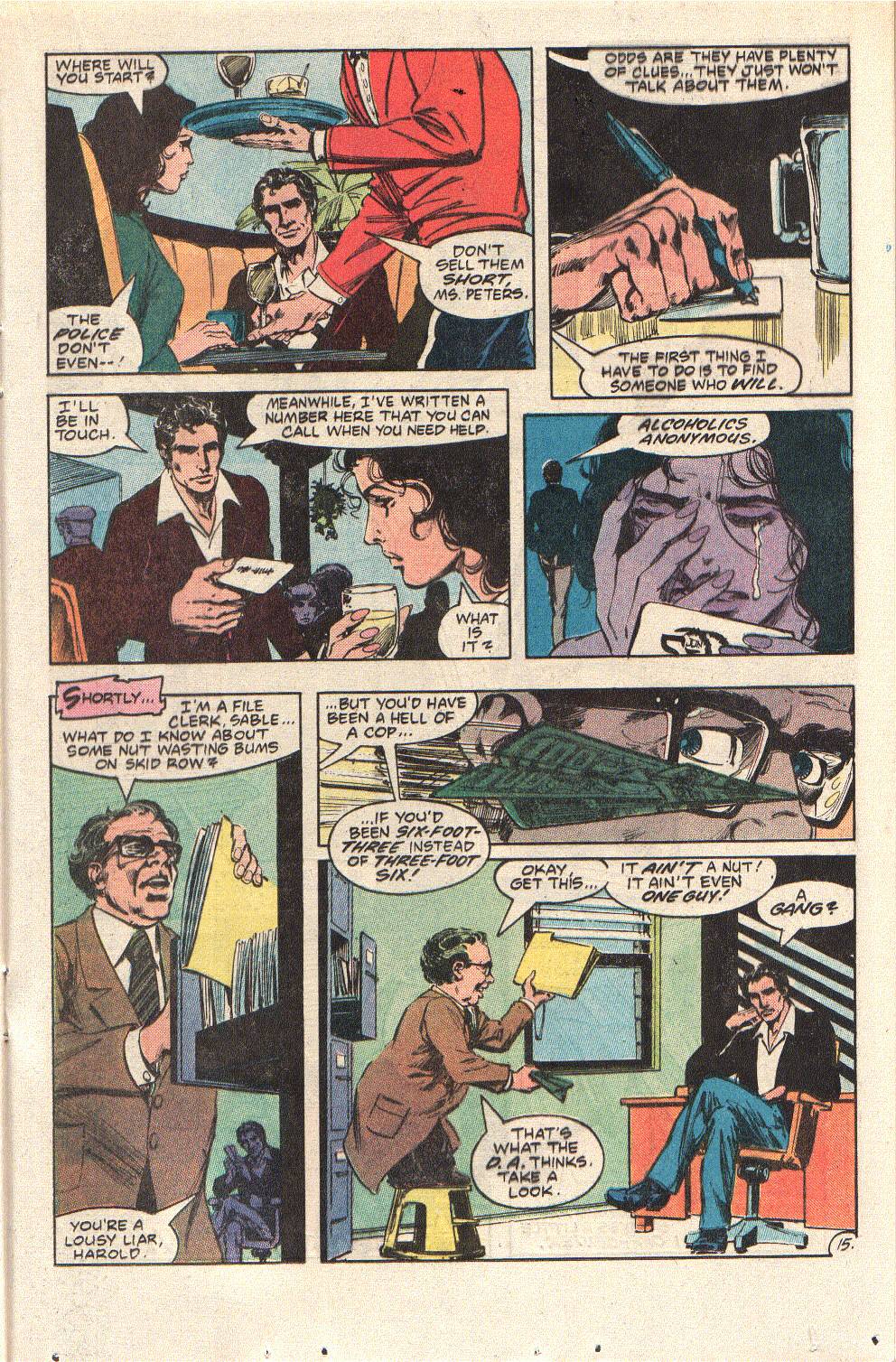 Harold shows him the case file, which reveals that the ballistics on each of the .45 cal slugs is different, leading the police to believe it might be the work of a gang, like some kind of initiation. They have only recovered one spent cartridge casing, at the site of the murder of Laura's father. It indicates a weapon whose firing pin strikes the primer cap slightly off-center. The police believe that if they can catch one of the gang members, they can get him to roll over on the rest and possibly turn up the weapons to match ballistics. Sable isn't convinced and asks how many gang killers take the time to pick up their ejected cartridges? Later, after dark, a man in shabby clothes turns into an alley and is shot dead, by a .45. Sable is nearby and goes after the shooter, firing several rounds which makes him bolt. Sable is able to recover the spent cartridge and contacts the police. Sable gives his statement, then goes to Forensics, without an escort and confers with a technician, who thinks he is an undercover cop. Sable then presents the man the recovered cartridge and tells him to alert Josh Winters that Santa came a little late. Sable meets with Laura, at his place, to give her an update. He says he believes it is one killer who is changing barrels in his weapon to throw off the police and that the cartridge he found indicates the same firing pin as the weapon used to kill her father. What he doesn't know is who the killer is and why he is killing the bums. The next night, Sable goes out again, in disguise and gets shot at from a rooftop. he returns fire but takes a round in the shoulder. He hides and the killer stalks him, but he is messing with a professional hunter and Sable suckers him by leaving his gun on the ground and slipping behind the man, when he investigates and plunging a knife into him. Sable meets with Harold, who bandages his wound and Sable disassembles the Colt and removes the barrel. He examines it and shows Harold that it is a new barrel, but is seems to have new grooves cut into it, recently. he ponders why and then hits upon an idea. He makes a phone call. An hour later, Sable meets with Mr Goldblum, the bodega owner, at his brother-in-law's grocery store. it has a modern UPC scanner and the man demonstrates how it works. Sable asks him to scan the ballistics photos of the bullets from the murder victims. It actually reads them and displays a set of numbers. Harold recognizes it as a WW2-era substitution cypher and uses a computer to decypher it. It reveals a list of names and addresses. mr Goldblum recognizes some of the names. We cut to a shadowy figure, who grabs a suitcase and starts quickly packing, before he is interrupted by Sable, holding his Mauser on him. he turns on the light and the fleeing man is revealed to be the police forensics technician, who Sable calls Oberleutnant Schtaffle (Lt Schtaffle), a war criminal who ran concentration camps. Sable reveals he figured out the added striation had to be meant to be seen by a foresnsics person and put two and two together. Mr Goldblum, a survivor of Aushwitz, recognized the names. Sable is bleeding again, from his wound. Schtaffle reveals he is part of a secret organization (implied to be ODESSA), which is working towards a Fourth reich and says the time is ripe, with conflict in the Mid-East and economic turmoil in the West. Raymond Peters devised the code system, but thought he was working for the army. Schtaffle had worked for the CIA, against the Soviets. Peters had to be eliminated. He is stalling for time, as Sable grows weak. Sable has heard enough and shoots Schtaffle, in cold blood. The story ends with a voice coming on the line of the telephone receiver, laying on a table, saying Sable's call to Simon Wiesenthal is ready. Thoughts: This is a very "hardboiled PI" plot and I suspect is one that was concocted when Grell first envisioned the series as Iron Mike, a detective series. It had all of the trappings of a Mike Hammer or Jim Rockford type of character and their stories. Sable stops a hold-up, gets grief from the police, for vigilantism, then ends up taking a case that is already an active police investigation. So,, of course, he is at odds with the police, except for his man on the inside. On the Rockford Files, Jim Rockford usually got into from Sgt Dennis Becker (Joe Santos). In this case, it is Harold, a file clerk and a Little Person. Harold doesn't turn up as much, in the series, as I recall; generally only when Sable is involved in a case the crosses into police territory. Josh Winters is a bit more frequent, as he allows for more narrative possibilities. In the Sable tv series, the function of Harold was replaced by a blind computer hacker, called Cheesecake, played by stage actor Ken Page. It seemed an odd change; but, the addition of the African-American actor did add a touch of racial diversity to the mostly white cast. Grell sets this up as a classic PI mystery, doling out clues along the way, which we encounter as Sable does. first, there is the forensics report, showing that all of the bullets have different striations, from their respective barrels (where the rifling of the barrel will grip the projectile and give it a spinning motion, for greater accuracy). However, it is noted that they have one recovered cartridge, which stands out, telling us that it is an important detail. The police theory, that this is a group of killers, sounds plausible, based on the bullets. it's the cartridge detail that suggests something else, as Sable points out: why would gang members take time to recover their brass? Only if they wanted to hide something about it. That means it is a key piece of evidence. Sable is then able to recover another piece of brass and verify his hunch that it is the work of one man, as the firing pin is the same. As Sable notes, field stripping a Colt automatic is fairly simple and a trained user can do it in seconds (we learned to do it when I was a midshipman and I can still recall the procedure) and it is a simple matter to swap the barrel with another. He demonstrates with the weapon recovered from the man he stabbed and it has the same firing pin and a new barrel. It is then that Sable notices the markings added to the barrel. Rifling of a firearm barrel will create striations on a projectile, in a specific pattern. The added marks will further add new striations. The opening scenes and dialogue, in the bodega, brought up UPC scanners, in grocery stores. Those were relatively new, in 1983, and expensive, which is why mr Goldblum didn't have one. he remarks about the UPC code, a series of lines which is read by a laser beam. the way it works is that the laser is emitted at a specific frequency and the black lines alter the frequency in specific ways, based on the thickness and sequence of lines. This then creates a value, which the computer converts to a meaning, like a price or an inventory code number (known as a SKU, most often). This both inserts the price and allows on-hand inventory to be tracked, allowing for more timely ordering and real-time inventory controls. Sable realizes that the marks in the barrel are creating a similar effect and hits upon a hunch that they are interpreted in a similar manner, leading to the scene at Mr Goldblum's brother-in-law's store. Sable has him scan one of the photos and the laser produces a numerical value. Now, where Grell nudges things, a bit, it that Harold recognizes a cypher. In reality, unless the formatting of the bar code matches the scanners programming, it will not return a value. However, I doubt Grell knew that, unless he was moonlighting in a retail store, while drawing Warlord. Grell makes another mistake when he meets up with Schattle (again, as he met him under his assumed name, as the forensics tech) and calls him Oberleutnant, while noting he was in the SS. Oberleutnant is a Wehrmacht (Army) rank and not an SS rank. The SS equivalent rank for a 1st lieutenant (the English equivalent to oberleutnant), is Obersturmfuhrer. I think Hollywood is mostly to blame for that, as SS officers are usually called by Army rank, in war films. The overall purpose of the killings is a bit murky, other than to eliminate Peters, as he devised the code. it's not entirely clear if the other victims were part of the organization or if they were just shot to deliver the ballistics codes to Schattle and that Peters was the only specific target. What we do know is that it relates to SS war criminals, who were involved in Auschwitz and other death camps and atrocities, and are part of a secret organization. Grell doesn't name it; but, he probably means ODESSA, Organisation der ehemaligen SS-Angehörigen, which means the Organization of former SS Officers. This was an actual group of SS men, who developed escape plans for SS officers who were wanted for war crimes, such as Adolf Eichman. Many fled to sympathetic nations in Latin America, such as Argentina and Paraguay. ODESSA was more of a catch all name for various networks used to get Nazis out of Germany, rather than a formal organization, and originated in n Counter-Intelligence Corps memo, from 1946, about code words used in prison camps, to curry special Red Cross privileges. It became popularized in fiction by novelist Frederick Forsyth, in his book The ODESSA File. In that story, a German journalist comes into possession of a diary of a Jew, who committed, out of depression upon recognizing that a prominent German factory owner was a former SS commander of butchery in Riga, Latvia. The journalist tries to investigate and finds himself targeted for murder and also comes in contact with MOSSAD agents who want to use him to infiltrate the ODESSA network and get close to the man identified in the diary, for their own reasons. The book was a major bestseller and was adapted into film, in 1974 (the novel was published in 1972), with Jon Voight as the journalist and Maximillian Schell, as the former SS commander. Leaving aside the plot, this issue introduces another major member of the supporting cast, with Myke Blackmon. Myke is the illustrator of Sable/Flemm's books and here discovers that Flemm is actually Jon Sable. As we can see, she is intrigued by the man, because she is very touched by the warmth of his stories, yet now discovers that he is a cold blooded killer, or so the media presents him. This dichotomy will gnaw at her and lead her to learn more about Jon sable and his past, which will have far-reaching implications. That journey begins next issue, as Grell presents Jon Sable's "origin." Myke is an interesting character, as she isn't a conventional love interest, secretary, assistant or victim; the usual female roles in hardboiled detective fiction. She isn't even a client. She is a co-worker, though they haven't met, in two years of collaboration (which was often the case in comics, as penciller and inker might never meet or writer and artist). She has a masculine name, though with an altered spelling, which led Sable to assume his illustrator was a man. He is caught off guard when he finds that Myke is a woman, which alters his planned presentation. He also finds that she is a very confident woman, sure of her abilities and her worth to his work and she has a bone to pick with him. That puts him on the defensive and blows his strategy. he tries to retreat from the uncomfortable situation and Myke sticks to her guns and follows him, to have it out. That leads her to discover his dual identity, such as it were. This intrigues Sable and he seems taken with Myke, respecting her tenacity and take-no-prisoners attitude, not to mention her sheer honesty. He recognizes that she is right about his lack of communication and he backs down and takes time to collaborate with her. Myke has touched something within Sable, which Grell will slowly develop, which was one of the real "adult" elements of this series; the budding romance between the characters and the complexity of their relationship. Grell's own then-wife, Sharon, was also a writer and had been ghost-writing Warlord, before her name was included in the credits, openly. She also nearly put out his eye, when they fenced, prior to his producing Starslayer, of which he remarked in the intro to the first issue, talking about how he filtered real life into his work, though sometimes unintentionally. Further adult elements include a bit of innuendo, from Eden, as her cracks to Myke have a bit of double-entendre, such as when Myke asks if Flemm usually comes and goes so fast and she smiles and quips, "Not usually." It further cements the fact that Sable and Eden have a casual relationship and not a serious, romantic one. She is a friend, an agent, and an occasional lover; but, she is not his girlfriend or his true-love. She doesn't desire this and, as we will see, Sable is hesitant to engage in a deeper relationship, because of past trauma. We got a hint of that trauma, when Laura Peters asks about Sable's previous killing and he responds that it was personal revenge. Next issue, we will learn what the revenge was for. Some of Grell's art is a little murky, in spots and a few of his layouts have confusing panel progressions. The flaws are not major, but some people have had issues with Grell's layout style and find his work hard to read. I have always found it to be readable, though the odd page or two does require a re-read, as the flow seems wrong. Grell became noted as one of the many Neal Adams clones, when he began at DC; but, with Warlord, he flexed more of his own style and his more classical illustrative background, brining in more of his artistic influences, like NC Wyeth, Maxfield Parrish and Howard Pyle. Grell uses more old-school techniques, such as cross hatching (the proper way, not the way the Image crowd did it) rather than things like zip-a-tones, for shading. He also draws real faces, with quirks. Myke isn't a stereotypical "beauty," but an attractive woman, with a modern hairstyle, who dresses in her own fashion (and Grell was good with costuming, ably moving between action wear and formal wear, male or female, and have it look like real clothing). Eden is more glamorous, with heavier make-up, more traditionally feminine attire. Laura Peters is a bit in between, with her make-up marred by her crying and emotional outbursts, as you would expect. Grell would have certainly had an education in fashion drawing while working as an assistant to Dale Messick, on Brenda Starr. One thing you notice about Grell's art is his attention to details. Not in a George Perez "draw every brick" kind of way; but in conveying the textures of things, the fine details that identify things. His buildings have real architecture, his clothes have folds and textures, his bodies have actual body language. When Sable lights a cigarette, we see the vent holes on his lighter, and the sparking wheel. When Sable fires his Mauser or the killer fires his Colt Auto pistol, we see the action move backwards, as the released gasses create the recoil, to chamber the next round. Far too many artists draw the same gun, whether it is being fired or just pointed, while having no idea how it works. Grell has an extensive background in firearms (and hunting) and knows that when you fire an automatic pistol, the upper receiver (or "slide") moves rapidly rearward and chambers the next round, from the magazine. When he shows a pistol firing, he shows how it looks after the trigger is pulled. The Mauser is a bit more subtle, but, he does have panels, within the series, that show the action being blown back. It is not clear that he has a selective fire version of the Mauser, until he reveals it as such in a later issue. He has panels with rapid shots; but, it is a single panel and you cannot tell if it is meant to be auto-fire or just quickly fired semi-auto bursts. He also tends to show spent cartridges being ejected, especially since it is a major clue, in this story. many comics will have guns blazing, without ever showing a single cartridge casing flying out of a receiver. It's those fine details that separate artists, especially when they work in more realistic stories. Fantasy allows for more suspension of disbelief and acceptance of the fantastic; detective fiction not so much. Another great issue, which helps introduce the cast and showcase Sable's skills, setting us up to learn about his past, before we move forward, with his adventures/
|
|
|
|
Post by codystarbuck on Aug 7, 2021 22:31:54 GMT -5
Jon Sable #3 The title sounds like Jon and Eden's after-hours conferencing. Note the detail on Sable's hunting rifle (a double-barrel .375 Holland and Holland) and his hatband (a copy of the one Stewart Granger wears in King Solomon's Mines). Also note the water buffalo and trees, all authentic to the region where the story will take place, while juxtaposed against the New York skyline and Sable-as-bounty hunter gear. Indicia Gag: Close cover before striking. The interior cover, with Mike Gold's editorial page, features talk of the First Comics relaunch/continuation of Starslayer, after the demise of Pacific Comics. Grell writes and does breakdowns, Lenin Delsol pencils and Mike Gustovich (Justice Machine creator) inks. That joins the line-up of Warp, E-Man, and Jon Sable. Creative Team: Mike Grell-story & art, Peter Iro-letters, Janice Cohen-colors, Mike Gold-editor Synopsis: Myke Blackmon is in Eden Kendall's office, asking where Jon is...  He has disappeared, off on another adventure. Truth is not always what lies on the surface....  Jon Sable has returned to Africa and is told that people will be waiting for him. He's looking forward to it. Myke grabs a beer (or a Coke, kind of looks like their bottle) and settles down with the manuscript that Eden gave her, to explain more about Jon. It's titled "A Storm Over Eden." 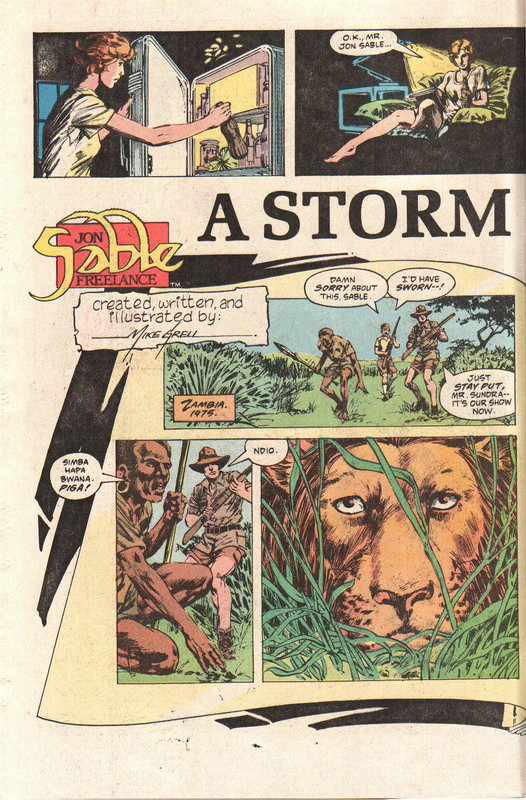 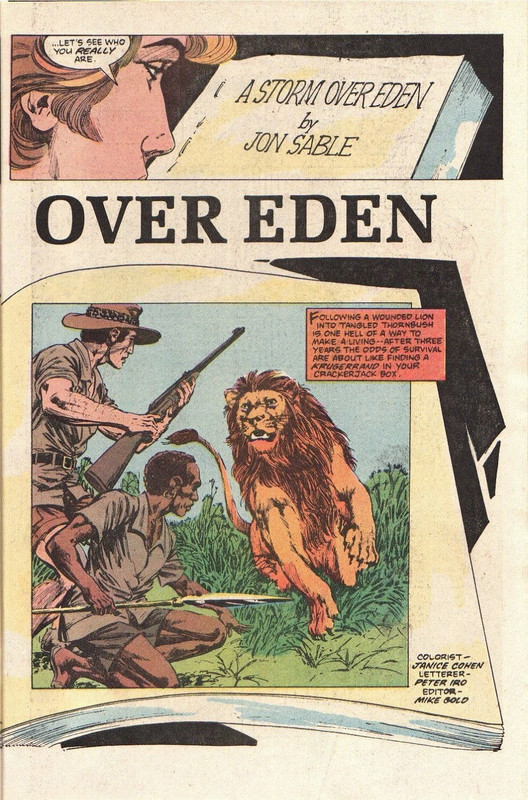 We cut to Zambia, in 1975, as Sable, a white man and a black tracker move through the bush. A lion charges from the scrub and Sable fires, but it plows into him. We cut back 3 years to 1972 and Munich, site of the 20th Summer Olympic Games. Sable is a member of the US Olympic Team, competing in the Modern Pentathlon (epee fencing, pistol shooting, cross country fun, freestyle swim and equestrian show jumping). he and a teammate see the sights and Sable comes across one he likes very much, a blond woman, buying violets from a street vendor. Sable tells his friend to go practice his backstroke as he tries his German on the fraulein. However, she actually speaks English, catching him off guard and further throws him by saying she is Kenyan and an athlete and Sable strikes out, though the woman is smiling as she walks away from the ashes of Sable's ego.  The woman is Elise McKenna, a gymnast and we see her compete in the floor exercises, but she doesn't do well enough to medal. She is presented with a consolation prize of a bouquet of violets, from a sympathetic fan, who tells her she could have fallen, to curry sympathy, but she is no quitter. The gesture and the empathy catch her off guard and she asks the fan, Jon Sable, his name. Next it is Sable's turn to compete and he finishes 4th, out of medal contention; but, he says pentathletes don't peak until their early 30s; so, Montreal, in 1976, may be the place for him. Elise hands him some violets and says maybe he should have just fallen. Elise and Jon share a consolation dinner, as Elise says she is giving up competition, as the sport belongs to the young girls, like gold medalist Olga Korbut. She at least has a Silver Medal, from the 1968 Games, in Mexico City. She asks Sable if he minds being with a has-been, and he says not if she doesn't mind being seen with a never-was. They get to know each other. Elise's father was British, in the diplomatic service, and stayed in Kenya, after independence. Sable does some freelance sports writing, when not training. They walk and talk into the early hours of morning. Elise tells Jon of the sable antelope and says the name suits him. he quips it's better than being named after a weasel. They share a kiss, then another. They notice some people climbing the fence into the Olympic Village and assume they are athletes, who broke curfew. They have no worries there, since they are done. They are about to leave the area, near the Israeli team quarters, when shots ring out. 23 hours later, 11 Israeli athletes and coaches, 5 terrorists and a German policeman are dead. Jn and Elise grieve together, at a candlelight vigil, trying to make sense of the world. Despite the tragedy, the games go on. Elis boards a plane to return to Kenya, and finds a surprise on the plane. Jon asks if Kenya is interested in a hot pentathlon prospective, in 1976. They are married under a tree, in Kenya...  Jon and Elise build a home along the border region between Botswana, Zambia and Rhodesia, some of the best game country in Africa. They receive their safari license and their new business has begun. Oh, and Elise is pregnant. Jon sits her down, steps back and lets out a Tarzan yell, while beating his chest. Elise tells their unborn child that its father is a lunatic. We then see a little blond boy, named Mark Andrew, who matches his father's yell, on power, if not volume. We cut back to 1975, as Sable crawls out from under the dead lion. Sable wrenches his rifle loose from its still jaws and pulls a tooth with it. The white hunter gets his picture taken over the carcass, while Jon and the tracker share private jokes about the "great white hunter." The tracker spots something and calls to Jon in Swahili (or so we are led to believe) and he leads him to an elephant carcass, left to rot, by ivory poachers, who took only the tusks. Sable radios the game warden, who turns up in a land rover and Jon tells them where the poachers are headed. he volunteers to help Hal, the warden, who we see Sable meet in the present, when he returns to Africa. He sends the tracker, Jacob, back to their ranch, with the "hunter", while he goes to help track the poachers. They catch up to them as they cross a river. Hal tells Sable just to back him up. Hal has an FN-Fal battle rifle...  ...while Sable just has his hunting rifle. Hal tells the poachers to give up and one opens fire with an AK-47. Hal returns fire and one of them runs into the bush. Sable goes after him, despite Hal telling him to stay. He catches up with the man, who attacks from above, hidden in a tree. Sable raise his rifle and fires directly into the man's stomach, with both barrels, cutting the man in two. Sable throws up. Jon returns home to Elise, safe and sound, saying they caught the poachers. he tells Elise he accepted Hal's offer of a job as a Game Control Officer. They need the income, as the civil war and poaching is killing off the safari trade. They look out at the beauty of the land, at what is real. Elise notices something is bothering Jon. She inquires and he answers....  Sable slumps down, after telling his wife he killed a man, torn apart by guilt and remorse. We see a baby girl, Heather, born and Sable at his job and with his family. We cut to Elise's birthday, as she works out with gymnastic exercises and Jon and the kids present a cake and a gift, Jon's good luck charm: the lion's tooth, set in a necklace. After dinner, sitting around a fire, Jon tells his children the story of a mythical place, New York City, and a group of leprechauns who come there to escape a potato famine and set up shop, manufacturing poteen, in Central Park....  The kids love the story and Jon is a natural storyteller. He tells them of the new leprechauns who join the firm: Jose, Kareem and Billy Bob, and J Michael Murphy, a whino who acts as an amusement park for the wee folk. The kids are asleep by the best part. The next morning, Jon goes out to cull a buffalo herd, thinning its numbers so it doesn't overrun its grazing area. It is dirty business, as it is just killing, reloading and killing again. Back at Sable's home, we see some men move in from the bush. Elise spots one and runs inside the house, where the kids are playing. She grabs Jon's FN and takes aim and fires on the men invading her house.  She takes down a couple, but a hail of bullets silences her weapon. The white man leading the group is told that Jon is missing. He moves them out, saying the ivory trade should improve anyway. Jon returns home and finds the door open and enters Hell.....  In the present, we see a hand with Sable's necklace around his wrist, as he holds the same magnum pistol as the leader of the killers. he is told that Sable crossed the border into the country and the man is happy. They will be waiting. Thoughts: A powerful story, a tragic tale. Mike Grell really steps up his game, as a writer. Through this manuscript, Myke becomes out guide to the life that Jon Sable lost. We see the young man, steeped in martial skills, at the 1972 Munich Olympics, where he meets his future wife, Elise McKenna. Grell tells us right away that happiness and sorrow are often intertwined and we have to enjoy the happiness while we can, and endure the sorrow as best we can. Their budding love is interrupted by slaughter, as members of the Black September group murdered 11 members of the Israeli Olympic team, two when they took them hostages, the rest slaughtered, bound and helpless, in helicopters, at an airfield. ABC Sports found themselves turned into newsmen, as their cameras were already in the Olympic Village and they broadcast scenes of the police attempting to negotiate the release of the hostages, while sharpshooters, disguised as athletes, tried to move into position, but the cameras revealed them on live television. The athletes were taken to helicopters and flown to an airfield, to board a plane, where the police planned t ambush them. It was a poorly planned disaster and only 3 terrorists and no hostages survived. The Games, held not far from the remains of Dachau, went on, with more death on their conscience. Sable and Elise endure and move on with their life. The couple marries and starts a family, in the cradle of life, Africa. They know joy and beauty, but they settled into a dangerous area. Rhodesia was in the midst of a civil war and poachers took ivory to fund weapons purchases. Men like Sable tried to stop cold blooded killers, with automatic weapons. The killers sent him a message and Sable's life ended in an instant of fire and smoke. Grell builds the story well, first with the humorous exchange between Jon and Elise, when he tries to pick up the beautiful "fraulein." next, we see the tenderness, as Jon consoles Elise, after a disappointing performance. She returns the favor, as she is attracted to this funny and warm man. Young love blooms and tragedy occurs, but they move on to a new life. Their family grows and we see their joy and love and the birth of BB Flemm's stories, as Jon entertains his small children with tales of leprechauns, in Central Park, with very non-Irish names. Then, when we see Sable with everything he ever wanted, it destroyed in a heart-wrenching moment. We want Elise to get the rifle and hold off the killers until Jon arrives to save them; but, this isn't Hollywood and Elise doesn't have enough bullets. Jon is too far away. In a moment, life is snuffed out and we feel Sable's grief as he collapses and cries out for his lost family. Myke now understands quite a bit. This sensitive writer is what remains of the old Jon Sable, a warm, funny man who loved his family and entertained them with colorful stories. The rest is what emerged from the ashes of his home and family, a hardened agent of vengeance and violence. Myke grieves from the man who was lost. Grell gives us light with the darkness, in several spots. Sable's swimmer teammate, with a dark mustache bears a striking resemblance to a certain winner of 7 Gold Medals, named Mark Spitz. Spitz was actually taken away from the games under security, because he was Jewish and it was feared he might also be targeted by terrorists. Sable and Elise share playful banter and Jon and Jacob, the tracker, play up the stereotypes for the tourists and laugh at them behind their back. Grell also indulges in his love of Tarzan, as Jon lets out a Mangani cry, at the announcement that he is to become a father. Grell had only recently relinquished the Tarzan newspaper strip, after drawing it for a year and a half. The tales of leprechauns are charming and Grell adds a little in-joke, as we see them recruiting new workers, with the proviso that they must be able to walk under the belly of a beagle and we see an elf who is too tall and is told to try Poughkeepsie, as they are hiring. The elf is drawn in the style of Wendy Pini's Elfquest and Poughkeepsie is where she and Richard set up shop, as WaRP Graphics. We have a double layered tale (3, really) as we see Sable's past and his loss, while, in the present, he returns to Africa to track down the men responsible for the loss. While this goes on, Myke reads the manuscript that details Jon's past. She wanted to know more about him, to understand him and has discovered how dangerous an idea that was. meanwhile, we also get some insight into Jon's reaction to Myke, as she seem to get the better of him from the start. Could it be because she reminds him of Elise? Her sense of humor is similar, as is her self-assured manner. Perhaps that is why he apologized and gave her the time she needed, in the previous issue. Perhaps that is why the hotshot mercenary has trouble dealing with her. Again, Grell's attention to the details really work in favor of the story. he captures the beauty of Africa, while also rendering the Bavarian charm of Munich and the grandeur and tragedy of the 1972 Olympics. He draws Sable in safari gear, right down to the ammunition loops on his shirt, for quick loading of his rifle. His bush hat is styled after Stewart Granger, in one of the great movies of Africa, King Solomon's Mines, as Granger played the ultimate white hunter, Allan Quatermain. Grell did his research about Africa and big game hunting, drawing from the books of Peter Capstick, and American hunter and writer. Capstick worked as a hunter and guide in Latin America and Africa, starting in 1968 and was a game ranger in Zambia, Botswana and Rhodesia, just like Jon. Grell would eventually live out a dream and go to that region, on a hunt and shared images, both photos and sketches, in future issues, which led to more controversy than any single thing in the series. The previous issue included letters, based on advance copies, from people like Kim "Howard" Johnson, of Starlog and Comic Scene magazines, Beau Smith, future sales manager at Eclipse, and Bob Greenberger, of the same Comic Scene magazine. This issue includes a couple, from civilians. The interior back cover features a promo for First Comics next big series, from some guy named Howie.....  I don't know if it will be good; but, if it doesn't work out, he might be able to take up fashion design! I do think those ladies might want to research a good pediatrist.
|
|
|
|
Post by foxley on Aug 8, 2021 7:50:26 GMT -5
For me this is where the story kicks off and I knew I was dealing with something different from the norm. Grell packs real emotional into this issue (and the next), and the African scenes really highlight his strength as an illustrator. I was also impressed by his ability to weave real world events into his narrative. I am not old enough to remember the '72 Olympics (although I do remember my parents buying a colour television for the '76 Games), but I did know at least the basics of the Black September attack. And as an Australian, I had also had a general understanding of the various political upheavals in the former British colonies in Africa in the 70s, as more than a few white settlers relocated in Australia in the aftermath. That Grell refrains from portraying either side of these conflicts as mindless monsters is refreshing (and, quite frankly, unusual for American war comics). Grell reserves his true hatred for the poachers.
These two issues crystallized my love for Grell and turned me into a lifelong Grell fan.
|
|
|
|
Post by commond on Aug 8, 2021 9:13:25 GMT -5
I really liked this series for the first few years then the art started going downhill at a speed of knots and Grell lost interest in the title like he did with Warlord. The only thing I didn't like about the series was the children's author secret identity. I particularly hated that issue where the Leprechauns take over and Sergio Aragones does the art. The best thing about the series was Sable's struggles to have a relationship with another woman after his traumatic loss. Grell ended up exploring similar ideas and themes in his Green Arrow run, which is a pretty compelling case for auteur theory in comics.
|
|












